#BL archetype
Text
Younger Gay Identifying Elder Gay as MINE
I JUST LOVE IT OKAY!!!!! Favorite trope forever!

Minato’s Laundromat
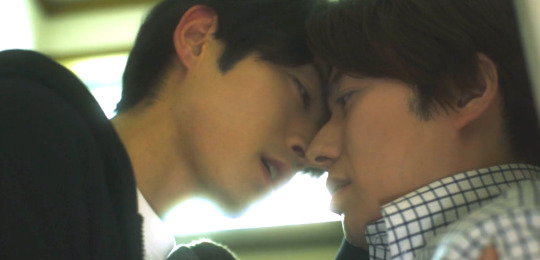
Old Fashion Cupcake

Guardian
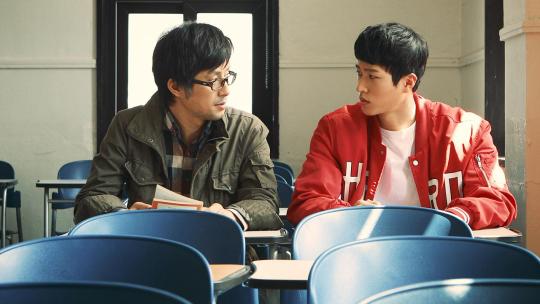
Private Lessons

Some More

Tasty Florida

HIStory 2: Crossing the Line

HIStory 3: Make Our Days Count

HIStory 4: Close to You (yeah yeah bite me)

En of Love: Tossera

Gen Y

2 Moons 2
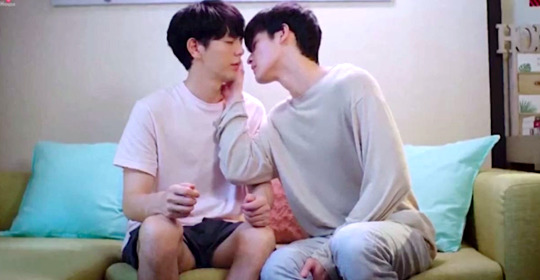
Lovely Writer

Manner of Death
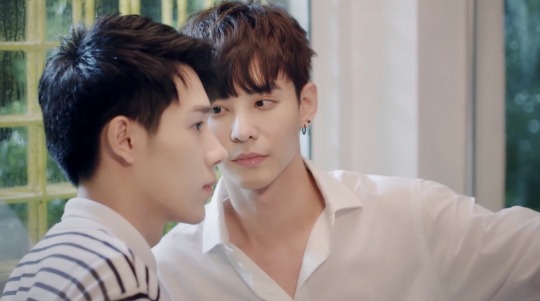
Oxygen
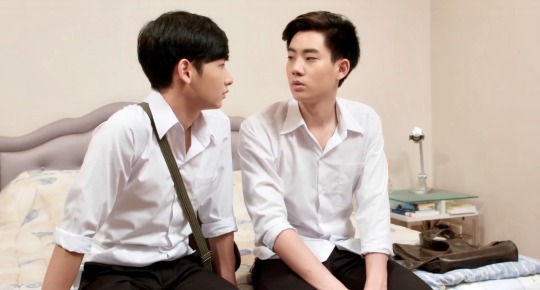
Puppy Honey
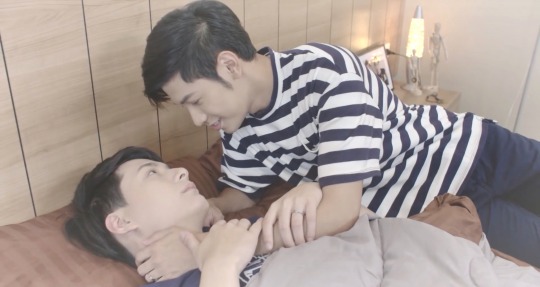
SOTUS

Top Secret Together

Until We Meet Again

Y-Destiny
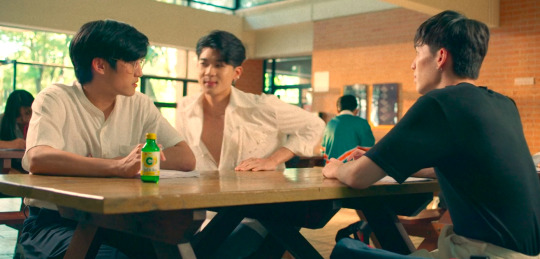
You’re My Sky
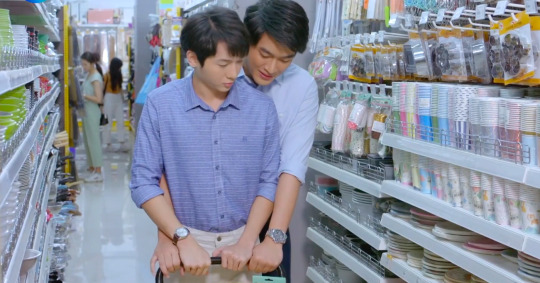
Brothers
AKA my CATNIP
(source)
#BL trope#BL dynamic#BL archetype#younger seme older uke#younger pursuer#You’re My Sky#Y-Destiny#SunNuea#Until We Meet Again#KornIn#Top Secret Together#copynampu#SOTUS#kongarthit#Puppy Honey#PickRome#OffGun#Oxygen the series#sologuitar#SoloGui#TanBun#Lovely Writer#SibGene#2 Moons 2#J9#MingKit#Gen Y#MarkKit#En of Love: Tossera#GunBar
575 notes
·
View notes
Text
i adore how mxtx sorta flipped the idea on the whole top/bottom thing with svsss, and just BL relationships in general.
making bingqiu very open to switching, not making the "bottom" super feminine and actually leaning more to the handsome side compared to the "top", how luo binghe is manipulative sensitive and cries easily, etc. one of the main themes in svsss is literally about sexuality (and possibly even about gender roles).
as a queer asian man myself, i absolutely despise the "yaoi archetype" and it was one of the reasons why i avoided consuming BL media. hell, years ago when i first saw heavens official blessing, i mentally groaned and went, "ugh, let me guess, the bottom is super feminine and innocent, while the top is masculine and experienced." of course, that's not the case now, but it's disappointing how that thought was there purely because of the god awful way fetish-y media portrays homosexual people and couples. because, believe it or not, we are not assigned male/female typical gender roles just because one likes to top/bottom (and even then, it's not even like that! some people have preferences, sure, but it's not so strictly "i'm top/bottom")
so, while i absolutely LOVE the english novel designs (especially luo binghe's cute curly hair, gongyi xiao, etc, and personally believe a lot of the takes from the western artist on the designs are an improvement), i am greatly saddened by people subconsciously assigning shen qingqiu as someone more delicate and feminine and luo binghe as someone super masculine and muscly. like, if you're going to have luo binghe depicted as the western design (i believe this stems from binghe being applied to more western ideals for men, and, admittedly, i actually really love his design), at least don't make shen qingqiu feminine and delicate? don't have his appearance play into the stupid yaoi thing?
i get that people have different takes on svsss, especially how the western version depicts it. but, people just... seem to very over exaggerate the top/bottom roles when it comes to bingqiu (again, these two are, canonically, VERY open to switching).
it's weird, it's uncomfortable, and it comes across as, "so, who wears the pants in the relationship?"
so, can we please have more canonically handsome shen qingqiu? canonically beautiful and pretty boy luo binghe (they literallly state that binghe looks EXACTLY like his mom, su xiyan! while a more handsome woman, is still very beautiful!! plus it is stated several times that binghe is slim, and that shang qinghua made him that way!) or at the very least, a BL couple who actually look like normal people (ok thats a little hard considering binghe is literally supposed to be perfect) and not just a stupid fetishized version of themselves.
and no, i'm not saying that queer men shouldn't be feminine or men who are feminine shouldn't be in a relationship with guys who are masculine, etc.
TLDR: please stop twinkifying shen qingqiu and going against what mxtx defied for us queer men (the stupid yaoi roles). and for the love of whoever you believe in, do NOT think that i hate the english design or people's personal interpretation of characters, i just hate the subconscious assigning of gender roles to bingqiu and how media portrays and fetishizes LGBTQ+ relationships in general.
edit: also i love teardrew's (check them out on twitter!) interpretation of shang qinghua. while i do really like the the eng novel design's tiny scared hamster vibes, teardrew's version just radiates "up to no good, paranoid but suspicious looking bitch" rat man and i love it so so so much. i'm not gonna repost their art bc i don't know how they feel about that but perhaps you can search up "svsss designs" on here, you'll see it pop up eventually lol.
edit 2 (1/16): i just saw someone reblog a post (that im pretty sure was referring to this one because, well, if you saw it i think it'd be a little clear kahxj) that was about how bingqiu switching and completely eschewing traditional top/bottom dynamics was a fandom idea or smth? so now i'm wondering, since i swear i remember that they were open to switching, but it's just that sqq preferred to bottom and/or was just a little too lazy to top. plus, sqq is a pretty unreliable narrator who says he doesn't want something one moment and then he does. how could he say no to bingbing? esp if he seems to wanna try bottoming too. perhaps i'm mixing things up though, idk? so if anyone can find that passage that says he only and strictly wants to bottom or whatever please show me! but i think the point of this post still stands haha (i wanted to ask about it, actually, but when i clicked on the og post's user it turned out that they blocked me ? so that was a little surprising oops. hey if ur somehow reading this, im... sorry for making you want to block me bc of this post? akdhxjj)
#JOIN THE 'STOP TWINKIFYING SQQ' GROUP#did i make sense? i have no clue i just wanted to rant about this#i really pulled a cucumber bro there huh#this also applies to GL#thinking about it more#there should be trans men and women bl and gl#and not in a fetishy way#of course luo binghe is still the big strong protag and taller than sqq but come on#i dont believe luo binghe is a twink exactly?? maybe?? but just feminine in a historical chinese male ideals way#for edit 2:#i was just saying how it made me happy that mxtx didn't follow the yaoi archetypes and how i lov her for it <3#never said bingqiu was never done before and COMPLETELY flipped it over skdhjx#but i do believe that bingqiu did a good job providing variety and such :)#same goes for mxtx's other works as well i love her stuff sm#svsss#mxtx svsss#the scum villain's self saving system#luo binghe#shen qingqiu#luo bingge#shen yuan#luo bingmei#bingqiu#luo binghe x shen qingqiu#danmei
381 notes
·
View notes
Text
So, something I've been thinking about since watching Intern in my Heart for the BL side couple is that one of my favorite and very rare archetypes is the 'straight for society' archetype. Which lead me to think about the 'gay for you' archetype/trope because they're so similar but also completely opposite.
So!
Straight for Society is a specific archetype based on queer characters who, due to the heteronormative society they live in, do not even consider that they might be queer when they absolutely are. That part is important. This is someone who is queer but never thought of it or considered it because the world had told them that they aren't, simple as that. The most extreme version of this is Tonhon from Tonhon Chonlatee.
(Let me be very clear here, I love Tonhon Chonlatee. Love. Is it good? No. It is amazing? Yes. I adore Tonhon and I love Chonlatee and Neo was glorious in that how and I loved Chon's mom and just the entire friend group was basically perfect... anyway, yeah, just to be clear, love it.)
Tonhon never thought he might be queer because society and his family told him that it wasn't even a choice to be considered and so he never let himself consider it until he was confronted by his own desires in the most literal sense.
And that's what I'm feeling from Grey in Intern in my Heart. He feels like the kind of guy who was always masculine and always tough and so the idea that he was also queer just never occurred to him, especially as he's also obviously attracted to women making it easier to just never consider that as an idea.
But I feel like some people find it hard to distinguish it from gay for you. Which is a distinctly harmful and negative trope (or archetype, depending on how you use the terms and how specific we get with this) that I hate.
Gay for you is about someone who would describe themselves as straight basically saying that they are making an exception for this One Guy that he now love and that it has nothing whatsoever to do with repressing his queerness or being in denial of his identity. He does not identify as queer in any way and it's not society holding him back, this attraction and love is a singular event in his life... or implied to be, at least.
Now, there is at least one exception to this and that is My Only 12% in which he basically goes 'look, I love you and only you and if you need me to identify as gay to be comfortable I will but I wouldn't have otherwise' and that's because it is very clearly set up as him accepting his attraction and then going with it for his identity. There is full respect for the queer identity he's going with and an understanding that while this might be an exception, it's not an exception in terms of gender but rather in terms of ever loving someone like this.
Uh.
Anyway.
All this to say... I wish we had more genuine straight for society characters. I supposed we're kind of getting one in Fire on Cooking Crush but that entire romance is my absolute nightmare... his character is great and, truthfully, a good example of this but the way they're written his relationship with Dynamite sets my teeth on edge.
#thai bl#bl tropes#bl archetypes#straight for society#gay for you#i just wanted to word some thoughts
24 notes
·
View notes
Text
I was originally going to post some meta about how ayan comes from the 'tyrant top' archetype of BL/yaoi characters. He's quite persistent, he pushes against people's boundaries (though admittedly in a respectful and even healthy way at times), he strongarms akk into their relationship (even past points where akk had said no), he tries to strongarm thua in ep 11 and it backfires etc etc.
anyhow, even though i lost interest i think you all should look at the evolutionary parsimony tree i made about it:
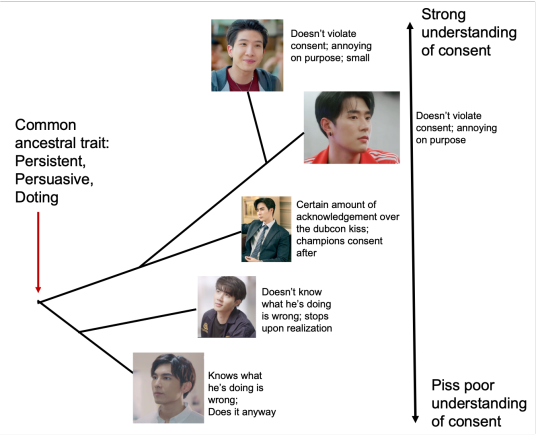
#the eclipse shitposting#the eclipse series#the eclipse the series#thai bl#ayan#this is what i use my phd for#i love that zee is here twice#im not a fan of this seme archetype#and the kind of stories are told around them#but i do love all five of these characters lol
49 notes
·
View notes
Text
I love it when Pond and Pete interact because i just know that if Ae had any say about it without looking like a deranged possessive twat, Pond would be dead thus Pete wouldnt have a Pond to even talk to in the first place.
Pond is the perfect character. He is so insufferable and even though he is an effective wingman, yall bet that Pond will be annoying about it. I love him so much
#love by chance the series#LBC Pond#we need a pond archetype character in every Thai BL series so that we dont spend the first part of the series pining#let pond push both of the main characters in the proverbial broom closet to force them to talk about their feelings
5 notes
·
View notes
Text
Hard Love Mission must have a backstory where Putter saw Yoshi previously and fell hard so he's arranged this whole setup with Louis because if not then it's entirely too fake (yes, yes I know but you know what I mean).
On the other hand I do love a younger Seme/older Uke dynamic so am sticking with it. Tropes already include forced proximity, ONE BED etc and bad tropes of scheming femme baddie and female rival.
Deferring opinion for a few weeks.
#hard love mission#putter x yoshi#thai bl#thai bl archetypes#oh we’re getting all the tropes.#asian lgbtq dramas#asian bl
10 notes
·
View notes
Text
My only 12%
I am on ep 1 and I am not sure if I will finish this series. The premise is interesting and many have raved about it but I went “Oh no!” when I recognized Earth, the actor. I hated Tar as a character, was meh about past Pharm, and I am not really vibing with Eiw. I think it is because his acting in all of them brings sth too close to the damsel in distress archetype for my taste. Is it really his acting or maybe he is handed this type of characters.
I was originally a romance reader, a voracious one, and there was nothing worse than dropping hard earned money only to jump into a story and hate a character. I could not stand what some called the “too stupid to live” heroines. There is a line between a knight on a white horse sweeping to the rescue a heroine in eed of help and a character that is only there to look pretty, be admired and let the hero show off.
When I discovered fandom and fanfiction, slash pairings were much more popular than het pairings. In some fandoms, het pairings were even quite rare. Despite some characterization crimes by some authors, it seemed that pairing two guys was not only the perfect recipe to avoid the dreaded Mary Sue or self-insert fics, but it also opened the doors to new dynamics, conflicts and tropes. Two handsome guys? Bring it on!
I jumped onto m/m fiction and onto queer films and continued to enjoy the stories and the quirks specific to the genres. Around this time I finally realized I was ace, so I guess that this is sth that colours my views and my enjoyment as well. Romance or erotica can get my neurons sparking and I enjoy it, but do not translate to real life.
So now that I jumped into bl and its influences from yaoi/manga, there are some archetypes that do not work for me. The type of characters that made me pull my hair in romance books, that I avoided in fanfiction, that some love and adore as cute and I want to grab by the shoulders and shake some sense into, yeah those characters are not for me.
TL;DR I just started My only 12%, was very excited after seeing many positive things on the dash, but I was slapped in the face with a character type I don’t like as a main lead and I might just drop it.
1 note
·
View note
Note
So I was thinking about how I like that in The Eclipse, the seme is shorter than the uke for once, and wrote in the tags that I do enjoy a good size difference in which the seme is bigger than the uke, though, like with Deanpharm and Seanwhite.
But then I remembered you explaining that Doms are necessarily the semes nor subs the uke. And with Deanpharm and Seanwhite, the interest is entirely mutual and equally pursued(though Pharm is a total Blushing Maiden), but there IS a strong D/s vibe in both couples.
So my question is, is there a seme/uke dynamic in those relationships?
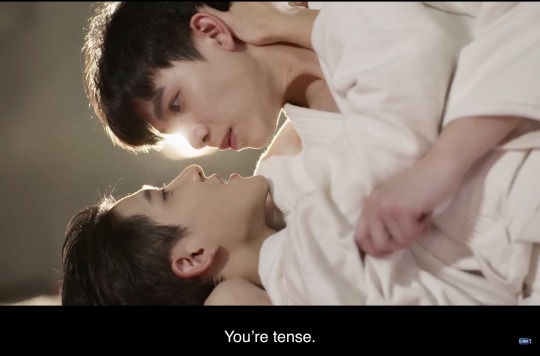
So right now I'd argue that there is none with the leads in The Eclipse. I mean Aye is the active aggressor but is that just flirtatious character or does he have intent to pursue a real relationship or is there an ulterior motive? What happens if Akk decides to flip the dynamic? Which he certainly could at any moment.

Eclipse is a lot more like Bad Buddy in this regard. Which I don't think really had seme/uke. I love it that Thailand is finally moving away from this model.
Vice Versa Jimmy is shorter but his character is clearly the aggressor but also is in doubt with a possible ulterior motive, and being an ACTOR character his interest can always be considered performative. Also I am pretty sure they are going to play with us, and roles, because of that title. Or they will if they’re clever, and it feels like them might try to be clever with this one.
In Sky in my Heart Fah also shorter, but definitely the seme, mostly because I doubt Mek could play an uke to save his life.
Incidentally actors who have successfully played both roles number essentially 2: Gong Jun (Advance Bravely and Word of Honor) and Tay Tawan (Kiss series and 3 Will Be Free).
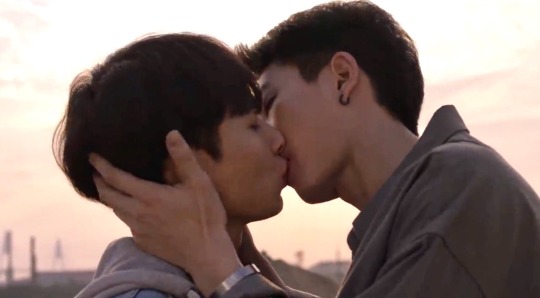
SeanWhite I don’t think really had much seme/uke. I would call it a weak dynamic and a lot of the seme/uke feel came from OffGun’s style and pre-existing dynamic. But also I’d argue Not Me isn’t really that much of a BL so it doesn’t bother to bow to the conceits of the genre.
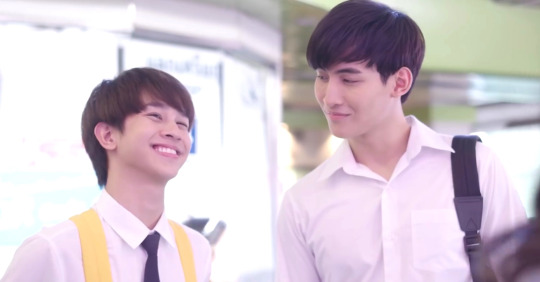
DeanPharm on the other hand, I would call classic seme/uke. Practically poster children. Their alter selves were not, and that’s part of the disconnect and discomfort with the reincarnation. Pharm lost much of Inn’s autonomy to fear and timidity because of how his past life ended. Just because Dean is soft and a great communicator never discount his semeness. He is entirely in charge of pursuing their relationship, it’s just he’s also willing to back off because his past self was the one that fucked up and he must atone for that. Part of that atonement is limiting his own needs and desires in a very un-seme way. But in the end he gets what he wants.
More like this?
BL couples where there is no seme/uke
Demi Seme
Strong Seme/Uke But Still Gentle?
Any BLs where the seme has more feminine traits?
Aggressive & Autonomous Ukes in BL - when the Uke Forced to Undertake the Seme Role
Instances of seme/uke role reversal?
#live action yaoi#seme uke#seme uke discussion#bl trope#bl archetype#DeanPharm#Until We Meet Again#Not Me#SeanWhite#OffGun#Tay Tawan#Gong Jun#Sky in my Heart#Vice Versa#gmmtv#Bad Buddy#PatPran#The Eclipse
75 notes
·
View notes
Text
On the subject of consent in recent BLs
In this analysis, I will take a look at several love scenes in recent Thai BLs, how they frame consent and the sexual agency of the characters, and why those matter.
(KinnPorsche deserves its own post: I’m sure people have already written in detail about how much emphasis is placed on issues of consent/non-consent throughout the show and how fundamental consent is to the relationship arcs of both KinnPorsche and VegasPete, and I won’t belabor the point here. Also, special shout-out to The Warp Effect for what it brought to the conversation about gay sex, but TWE isn’t technically a BL so I decided not to include it in this analysis.)
I am going to take a closer look at the following shows in this essay: Not Me, The Eclipse, A Boss And A Babe, Step By Step, and La Pluie.
Not Me and The Eclipse predate the other shows by two years/one year respectively, but I feel it is valuable to include them here because both show very explicit negotiations of consent that I feel are spiritual successors to the wonderful scenes we’ve been getting in the other three shows.
Why am I even writing this? There used to be an unfortunate tendency in the genre to have a power imbalance between the “seme” and the “uke” character, which translated into the seme deciding when to have sex and what kind of sex to have—and even though recently, several shows have done good work in dismantling the seme/uke dynamic and questioning the associated stereotypes, it cannot be denied that the archetypes are still an important part of most BLs, and even in cases where the tropes are played with and questioned, understanding those subversions still requires a knowledge of and familiarity with the original tropes on the part of the audience.
However, gone are the days of Until We Meet Again and Dean’s “I’ve waited long enough, make sure you’re ready.” (I enjoyed UWMA a lot but that was. Yeah. Not Great.) Now, we see characters actually talking about and negotiating their limits, and doing what feels good to them.
Let’s start from the very beginning. Not Me was an absolute trailblazer in this regard, and not mentioning it here would be a gross oversight. The first time Sean and White have sex, it happens in their version of the beach episode. (Which, in Not Me, is the two characters briefly living in a tent inside an abandoned building. This show is the best.) Sean and White are removed from their usual environment and protected from the outside world by two barriers: the walls of the old house and the tent that’s literally enveloping them and giving them a space that is unequivocally theirs, shared, in which neither one of the characters has any sort of power over the other. And what happens in that space when they’re about to have sex is extremely interesting: the first thing Sean asks is whether White is afraid of him, which White denies. The following exchange goes like this:
White: "So, what are we doing?"
Sean: "What should I do to you?"
White: "That’s up to you."
(Watch the whole scene here.)
I find this exchange incredibly meaningful because this already turns the seme/uke dynamic that can be found in a lot of other shows on its head. OffGun as a branded pair can easily be stereotyped into the seme/uke dynamic just because of their physical appearances, and clearly spelling out that both characters have agency in this scene is incredibly important.
And then it gets better! Sean assumes that White is sexually inexperienced (which is not true but the fact that White was actually in a relationship with a woman back in Russia never comes up again after the pilot episode, so maybe the show expects us to assume this, too), and suggests they try different things and White can tell him what he likes and doesn’t like. Compared to the stuff we’re getting now, this scene isn’t very high heat at all, but it’s one of my favorite intimate scenes ever because them asking each other “Do you like this?” after every kiss, every touch, is so incredibly unique and transports a wonderful sense of figuring out sexual pleasure together, as a couple.
Sex in Not Me is not something one character does to another, it is something that is discovered and shared together, and we even get an afterglow scene in which they gently tease each other about their fast beating hearts. (And don’t get me started on the importance of White choosing to ask Sean whether Sean is okay with White not being like Black in that moment right before they have sex, because he doesn’t actually want to have sex with Sean as Black! He wants to discover and share intimacy with Sean as White, as himself, not as his brother! The layers!)
Anyway, I think that scene paved the way for a lot of the conversations around consent we’re now getting in BL, just because it is so explicitly, unashamedly putting forward a definition of sexuality that has nothing to do with one character actively giving and the other passively receiving, but frames intimacy as something that is built together. (More on giving and receiving later!)
Now, moving on to The Eclipse. I decided to include the first time Akk and Aye have sex for a different reason: while we don’t really see them actually talking about consent, we see them practicing non-verbal consent. Let me explain. Akk’s and Aye’s whole thing is teasing each other. At first, Aye is usually the one doing the teasing, but Akk gets the hang of it towards the end of the show and teases his boyfriend right back. When they’re in Akk’s childhood bedroom together, Aye clearly alludes to the fact that he thought they might use this opportunity to have sex for the first time, which Akk pretends not to understand, all while alluding to it himself. I love this guy. (Watch the whole scene here.) Anyway, Akk says he wants to sleep, lies down and once again, tells Aye jokingly he just wants to sleep, clearly expecting Aye to do what other BL protagonists do at that point and not take no for an answer (sidenote: I HATE the “saying no as foreplay” trope with a passion and as far as I’m concerned it should die already).
However, Aye is not like other BL love interests, and he backs off. He stops touching Akk, lies down with his back to Akk, showing Akk that he takes him by his word: if Akk says he wants to sleep, Aye is going to let him do just that. So now, it’s on Akk to say that, no, that’s not what he meant, can Aye please come back to cuddle. And then Akk is the one to escalate from cuddling to kissing, which is extremely important: we know that Aye has been ready to have sex with Akk since forever, it’s Akk who’s been having hangups about intimacy this whole time.
They don’t put consent into so many words on this show, but Aye shows Akk that he respects his limits and that Akk only has to tell him he doesn’t want to do something and Aye will take him at his word.
So, these are, to me, two foundational scenes of establishing consent: one that shows consent as something that is established verbally, as an ongoing conversation, and one that shows consent as something that is established physically, by showing your partner that you respect their choices and limits by way of simply acting accordingly.
Now, let’s get into the fun part: scenes we got so far in 2023. I’m writing this post on the 13th of June, and I’m sure this year still has some great things in store for us, especially because Step By Step and La Pluie are both ongoing and neither of the main couples are actually together yet at time of writing. However, they’ve both already given us AMAZING scenes on the topic of consent, so I feel it is worthwhile to write about those already.
I want to start off by talking about A Boss And A Babe.
Let me just preface this by saying that the intimate scenes in ABAAB are some of my all time favorites in BL ever, because in them, sex is something that is just so normal. When Gun and Cher have sex, we don’t see them very passionate, excited, reluctant or wide-eyed innocent (which are some of the emotions traditionally associated with sex in BL). On the contrary, in every single scene that shows them being intimate, both characters are incredibly calm. They’re certainly happy to be with each other, but in a subdued way. Someone described their second intimate scene as them seeming like they’ve been married for a few years. They’re both just… incredibly normal about having sex with each other. It’s simply something they like to do together. It’s a part of their romance but it’s not more or less important than any other aspects of their lives.
And consent is at the very heart of it.
When Gun and Cher have their first time, we see Gun explicitly asking for consent two times: first, “Can I kiss you?”, then, “Can I do more?” The second one even comes with the promise that if Cher says no, Gun will immediately go to sleep without mentioning it again. And then it is on Cher to say yes, to pull Gun close and kiss him to show him that he is comfortable with taking things further. (In the show, these two questions were shown apart from each other, I cut together a version of the whole First Time Scene in its entirety, watch it here.)
Now, things get more interesting: the second intimate scene shows Cher initiating the encounter (watch the whole scene here). Cher pretty consistently falls into the uke category, both physically and as far as characterization is concerned, but he’s certainly not shy in the bedroom. And this time, he’s the one who asks for consent from Gun: Gun asks “You’re starting it?” and Cher’s response is “Can I?” Despite him being framed physically lower than Gun, basically at Gun’s mercy, he still seeks confirmation that Gun is okay with the way things are going. Not to overstate it, but to me, this feels revolutionary. Once again, we’re being shown that sex is something two people do together, as a shared activity, and that the “seme” character isn’t expected to just be up for it. He, too, has the right to say no.
On this show, sexual agency is taken extremely seriously, and it is clear that both Gun and Cher give each other space to decide what they’re comfortable doing. This is shown in non-intimate scenes as well: there are so many moments on ABAAB in which the characters negotiate physical touch and closeness, asking each other for hugs before actually hugging each other, Cher leaning on Gun’s shoulder in the car but not allowing Gun to touch him because that’s not what he’s comfortable with in that moment, and so on. (The only exception to this otherwise pretty consistent rule is the kiss in the car scene, which I’m still extremely confused about because it seems to go completely against Gun’s character. Who knows what happened there.)
Of course, the fact that so much emphasis is placed on negotiation and consent isn’t surprising on a show that has such obvious kink undertones and whose Our Skyy 2 entry basically consisted entirely of Dom/sub roleplay at work—I’m just saying, I think someone on the writing team is way into BDSM and knows all about the importance of enthusiastic consent from all parties involved, and I would like to send them flowers.
Step By Step hasn’t really reached the point where we can analyse the dynamic between the main couple (although we can take some educated guesses based on the interactions we’ve seen so far). However, last week’s episode had an extremely important scene between Pat and Put: Pat wanting to have sex with Put, then changing his mind mid make-out (watch the whole scene here). I really like the way this scene was done. No matter how shitty Put treats Pat at times, in this instance, he immediately understood and respected Pat’s change of mind without Pat even saying or explaining anything—at the end of the episode, Put says to Pat that Pat should tell Put when he feels ready to have sex. (We already know this will never happen because of course, Pat and Put are not endgame, but I do appreciate the sentiment.)
BLs rarely include a whole storyline in which the protagonist is in an actual, serious romantic relationship with someone other than his endgame love interest (hi Moonlight Chicken!), or if they do then just to up the angst factor. In this case, however, I feel that this scene raises our expectations for Jeng even further: if the guy who is definitely not a romantic match for Pat treats Pat with this much respect in the bedroom, then Jeng has to do at least that and then some. I do feel confident that Jeng won’t disappoint in this regard, but it’s fascinating to see a show frame this kind of respect as the absolute baseline minimum, with the endgame love interest expected to do even better.
Now, the one you’ve all been waiting for. The one that made me write this whole essay in the first place: La Pluie.
Oh boy. Where to start.
A week ago, we got an incredible make-out scene on Saengtai’s floor, which ended in Patts stopping the encounter because he could tell Tai wasn’t really comfortable taking things further—@bengiyo talked about that scene in detail here. And then, three days ago, La Pluie gave us the most unique, trope-defying, timeline-changing blowjob scene of all time, and I want to talk about it.
Tai and Patts are making out on their bed, Tai is not ready to go “all the way” and stops Patts from undressing him. We see a very realistic frustrated reaction from Patts, who nevertheless immediately stops and accepts Tai’s wishes—it is clear that Patts does not expect things to go any further at this point, and that he won’t pressure Tai into anything.
And then, Tai offers to blow him.
(Unfortunately, this show is only on iQiyi so I can't link to it, but you can get a good impression of the scene here.)
I mentioned the concepts of giving and receiving earlier: other people have said this more eloquently than me, but there is a tendency not only in BL but also in wider society to view sex in terms of giving and receiving, with a lot of expectations and stereotypes attached to the roles during different sexual acts. On other shows, that blowjob might be framed as a consolidation or an apology, something that the giver does out of a sense of obligation without enjoying it much. Not so on La Pluie! Tai is shown incredibly happy and satisfied afterwards, both when they’re sleeping next to each other, as well as on the morning after (see also @ginnymoonbeam's post about that here). Tai offered to blow Patts because he simply wanted to, not motivated by guilt or anything of that sort. And he genuinely enjoyed it! In the post I linked above, @bengiyo points out that La Pluie consistently centers queer desire, or more specifically in this case, male desire for a male body; much in the same way that the camera fucking loves Force’s body on ABAAB: the sensuality of the skin, the hands, the abs, the flat chests, the broad backs and shoulders of these men is explicitly emphasized, and Tai’s desire for a dick in his mouth is made absolutely crystal-clear. Of course, since this is a TV show and not a porno, we only see Patts’s thumb in Tai’s mouth instead of his dick, but the imagery, the implications, are clear as day.
And it is such a gentle framing, too: Patts caresses Tai’s lip lovingly, Tai opens his mouth slowly, seductively, then faces Patts’s crotch with a soft look on his face. We do get a clear sense of this encounter as tender, and gentle, and most of all, desired. Tai’s queer desire is at the heart of this scene, and at the heart of the afterglow scene as well. He wanted this man’s dick in his mouth, openly suggested it, showed Patts he was sure about his decision after Patts asked him whether he was, and ended up clearly happy and satisfied with the sex they had. This post, also by @bengiyo, goes into more detail on that.
This, once again, shows us sex as a conversation rather than a series of predetermined acts, shows us sex as a shared activity, as something that can be wonderful and intimate and make people happy without following what society views as “the correct steps”. I think this is extremely important because one part of queer identity is figuring out one’s own relationship to sexuality, one’s own desires and needs, and BLs that ignore this aspect fall a little short in my opinion. Sure, those men are kissing, but do they experience queer desire? Do they experience joy in their queer desire?
For me personally, a show that does not shy away from these questions is a lot more meaningful than a show that does, and consent is at the heart of it all. By framing sex as a conversation, as something that is built and shared together, the shows I looked at here are actively positioning themselves against the idea that there should be predetermined roles for partners during sex, and instead suggest that queer joy can be found in communication and consent. Understanding sex and intimacy as something that is built together, with both partners as equals in conversation, is just as radically queer as a man waking up with a smile on his face after giving his soulmate a blowjob the previous night.
And quite honestly, a male character who clearly, passionately, unquestioningly communicates that he wants a dick inside of him—that is incredibly sexy. But maybe that’s just me.
#*mine#not me the series#the eclipse#the eclipse the series#a boss and a babe#step by step#step by step the series#la pluie#la pluie the series#i said ''is anyone going to write a 3k meta analysis on this topic'' then didn't wait for an answer
514 notes
·
View notes
Text
Japanese QL Corner
It's a quieter week as a few shows have just wrapped and the next wave hasn't started yet, but there is still Japanese ql airing, including what is shaping up to be an all time fav. Both of these current airing shows are on Gaga and I highly recommend watching!
Love is Better the Second Time Around

This show is so good, and so mature in exactly the way I hoped. And I don't mean mature as in explicit--there is sex in this show but it's not some wild heat level. It's mature in that it's a story about characters who know themselves, know what they want, and draw boundaries. Both Iwanaga and Miyata are going down as favorite characters for me; I especially love that Miyata is a more knowing and self aware spin on a really well known bl archetype (think Rain from LITA but if he actually knew exactly why he was reacting the way he was to Payu and was mad about it instead of just overwhelmed and confused). This week we got a lot deeper into his teenage hurt over Iwanaga and now have a firm understanding of why he's alternately giving into and resisting this attraction. I am looking forward to Iwanga figuring out how to repair the damage he caused and earn his trust back.
My Strawberry Film

This was easily my favorite episode so far of this meandering little show. Every week I am left wondering what exactly this drama is trying to say and be; it certainly doesn't feel like a bl. We have spent the vast majority of our time on doomed het romance while Ryo quietly pines for his oblivious friend in the background. But this week we finally got to know Minami outside of Hikaru's narrow gaze, and I like her a lot. Her scene with Ryo where they discussed their romantic woes and established each other as a safe zone was very sweet, and showed how perceptive she is about all these dynamics happening around her. I was discussing with @bengiyo whether the show is going for an aromantic read with her, and I'm not sure. I see the makings of it, but the presentation of her feelings on romance feels a bit muddled. I loved her calling Hikaru out on being self-centered and having absolutely no patience for his petty jealousy. Hikaru thinks he likes her, but he doesn't actually know her (or his own best friend). I liked the final scene between Ryo and Hikaru as well, and the terrible angst of Ryo's confession that he immediately took back. The way the lights and audio from oncoming traffic played over his face in that scene was a really fantastic way to communicate both a moment of clarity and a moment of fear in the aftermath. I'm curious to see where this show takes the ending; a romantic conclusion for the two boys would not feel genuine to me at this point, but I could see them leaving us on a note of burgeoning curiosity and hope.
Bonus: No Touching At All
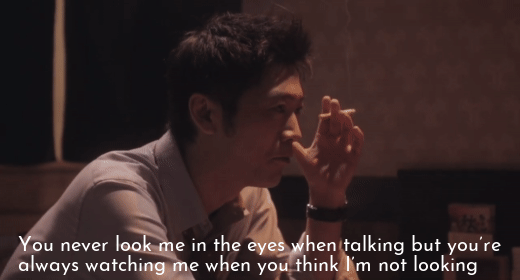
I recently watched this 2014 jbl on @twig-tea's recommendation, and I really loved it (I have already watched it twice and will definitely be doing so again). This is a classic office romance between a young gay man, Shima, and his "straight" boss, Toga. It's a simple story but well executed, and the film has a strong sense of place that I really loved. Shima and Toga have a fairly instantaneous attraction, and Toga is the kind of laidback character who simply never gave much thought to his sexuality and doesn't care about the fact that Shima is a man; he likes who he likes. Shima, however, is carrying a lot of internalized homophobia and trauma from closeted men messing him around in the past, and has a hard time believing in Toga's sincerity. I really love the way this conflict plays out in the story, and I especially love the way Toga talks to Shima. He's a no bullshit kind of guy and he tries his best to reassure Shima, but he's not a pushover, either. Ultimately Shima has to work through his own insecurities and make the choice to be brave to make the relationship work. The ending of this one is amazing and left me feeling very confident in this couple, and I can't recommend it highly enough. It's the grey for this one, unfortunately, but if you have trouble finding it in HQ let me know and I'll point you (don't watch it on YT, the version on there is potato quality).
#japanese ql corner#love is better the second time around#koi wo suru nara nidome ga joto#my strawberry film#no touching at all#japanese bl
122 notes
·
View notes
Text
Im so sorry but I just cannot understand people that read the entirety of scum villain and then say they don't like binghe. He's awful, toxic, overbearing, ect. Like?? Yes, but also no??? Did you not read the book? Or even looked past the unreliable narration?
Like, I get it, you're reading it in the moment and sqq is a super fun and imaginative narrator, he easily traps you in the same mindset that he has. Trapping you in the world of genres, tropes, character archetypes, what makes a story a story. So it's easy to get clouded like sqq and just scratch your head and try to figure out what type of character archtype luo binghe will turn out to be. If he's not the stallion protagonist harem master anymore, than what is he? So you read book 2 and the start of book 3 and you think, "oh! If he's not gonna be the toxic male power fantasy anymore, than he's gonna be the toxic male love interest fantasy you see in BL!"
You know the ones. They're incredibly sexy, incredibly tall, needs an incredibly in depth course on the meaning of consent and boundaries, and the narrative never punishes them for doing weird and out of line shit, but actively romanticize it. Which fits binghe in some respects, but not all of them, same as the stallion protag box. So I can understand you and sqq's apprehension throughout the story. Waiting for the hat to drop already. Is binghe a cute wholesome wife or a possessive bloodthirsty demon lord?
But then you and shen qingqiu are supposed to learn the lesson near the end that binghe is a person!! With thoughts and feelings and grievances he wants addressed!!! That ultimately he is in the exact middle of the harem master protag to toxic yaoi male lead scale, but also not on the scale at all!!!
Because, ultimately, he is just a guy that desperately wants to be loved! To be wanted! That's it! And shen qingqiu realizes this and takes this complicated emotional wreck of a man and promises him that love and companionship. Shedding the notions of following some sort of thought out narrative and live out their happy ending. Because scum villain's story does end up happy. Messy, but happy. Shen Qingqiu is not suffering. He does not regret choosing Luo Binghe. They are both happy and in love and they both deserve each other. So like, what more do you want?
#conclusion: yeah hes toxic bingqiu is so toxic but also not but also yes in the sexy way but also not-#literally scum villain is not scum villain without binghe#hes sooo interesting!!! he is malewife demon emporer sweet maiden sheep disciple harem master bad at sex husband narrative power source ect#he IS the center of universe but also he wants to live out his lesbian cottagecore fantasy for the rest of his days#also ps i do absolutely believe binghe does understand bounderies and consent and is a gentlemen#xin mo the embodiment of toxic masculinity just had a grip on him for a lil bit but hes fine now hes a respectful boy#literally says he'd never do anything without complete consent in one of the extras#sorry my rambles arent very eloquent and dont make much sense lmao#luo binghe#bingqiu#shen qingqiu#svsss#scum villain#scum villains self saving system
264 notes
·
View notes
Note
you know i've been thinking about the consequences of malleus's actions in book 7 and i realized how much he's fucked everyone over including his grandma. bc like other than the fact that he ob'd (which literally has NEGATIVE connotations one of which being is idk ""UNSTABLE"" which isnt necessarily a good look for a crown prince is all im saying) he's literally causing terrorism (??? can you call it that idk how else to call it) which is going to setback his grandma's efforts (and lilia's and baul's, and every supporter of his and his family) in keeping peace in their kingdom and the favor of the humans towards the fae. Like. i feel so bad for grandmother draconia rn i can only imagine the stress and pressure she's under.
Then theres also aside from PHYSCIALLY compromising everyone's healths in sage island (BECAUSE THE MAJORITY ARE HUMANS OR AT LEAST THEY DONT LIVE AS LONG AS THE FAE). He's also fucked everyone mentally twice over!!!! By booting them straight into a world where none of their problems exist. Now that wouldnt sound bad if it weren't for the fact that dreams have to end, and life isnt kind. It rarely ever is, and i can only imagine how distraught i would be if i were to say, hypothetically lost someone a year before and the wound is so fresh and raw and, in my dreams, they never died and everything is okay, then i wake up and realize that it was just that. A dream, they are still gone and i wish i never woke up which would be a LITERAL DEATH SENTENCE. This isnt just an event that takes place in NRC either BUT THE WHOLE ISLAND and that domain is GROWING, GROWING. I can't imagine just how many would be so emotionally ruined after this. Like.....
If Malleus does not suffer the consequences of his actions istg i will be so pissed, at least REMOVE HIM FROM THE PREMISE OR SOMETHING GODDDDDDD this cannot be remedied with a slap on the hand!!!!!
(Note: Sorry for the long rant. I felt the need to get this out of my chest bc i dont mind malleus's archetype actually nor do i actually hate him, bc i enjoy him interacting w other characters a lot (my fave ever vigenette is him giving deuce the equivalent of minecraft diamon for fixing a retrobit gaming toy) BUT GOD DOES HE MAKE MY BLOOD BOIL)



Yeah, I do feel like the scale of Malleus's actions cannot be understated. I know it's kind of a fandom joke that the OB boys are left off with a slap on the wrist + maybe some social ramifications at school, but this is the ONE time in the main story where things are getting super big and the effects could be cripplingly long-lasting.
I don't know if TWST will seriously address the consequences after book 7, but I sure hope they do!! There is a lot of interesting ground to cover (many points which this anon has already brought up) in a follow-up main story arc or the next book.
For example:
Malleus obviously has to regain the trust of his peers and staff. He didn’t really have it before but now has to work twice as hard to make connections since he just took a drastic action that confirmed the rumors some were already spreading about how he’s a monster.
He’s the sole heir to the throne and has just betrayed the trust of the people of Briar Valley. How are they feeling about him now? Do they still trust him to lead them?
How does this impact their relations with other countries (since Malleus himself stresses how he represents Briar Valley)? This is a problem visible on a global scale, and surely this would damage their rep with other nations, particularly the predominantly human ones. It’s setting back what is hundreds of years of trying to fix the broken trust between their races.
Malleus’s UM potentially puts his victims in physical harm; in book 7, Ortho suggests that since everyone is sleeping, their bodies are not getting the food or water they need. As a result, they may physically waste away and then perish. (We have seen that there are sleep blessings that keep people sleeping for hundreds of years without detriment to the blessed though, such as the one cast on Silver—so we cannot be entirely sure if Ortho’s theory is correct or not.)
There is the possibility that Malleus’s dreams may traumatize or retraumatize his victims, particularly those with deep rooted troubles. An example of this is Idia, who had suffered the loss of his brother when he was like… 8 years old??? But then in his dream, Idia is living a happy false reality that Ortho never died. When he finally comes to this realization, he has to relive the trauma of the discovery all over again and breaks down sobbing. We also see in the most recent book 7 update that Vil had to face the evilest aspects of himself and a dark reality; Rook became very emotional upon waking himself. Admittedly, Idia and co. coped with it well enough—this is proof of their character development and the strength of the new friendships they’ve formed. However, all the people on Sage’s Island/Twisted Wonderland may not react so positively or be so accepting of their cruel realities.
Again, just the overall moral dilemma of one person robbing all of Sage’s Island (and soon all of Twisted Wonderland) of their autonomy.
Potential extra work for STYX and whichever countries Malleus’s magic manages to spread to (repairing any physical damage caused by the thorns + mental damage done to those that fell asleep). That’s money, time, and resources that aren’t going toward other everyday endeavors.
How will Malleus himself mentally and emotionally cope with what he has done? Is he going to show remorse and shame? How does he plan on rectifying his actions, if at all?
Will this change how his dorm members + family view him? For example, will Sebek become disillusioned with his liege/realize Malleus is not as perfect as he seems? Will Maleficia blame herself for not being there for Malleus? Will Lilia feel guilty for not teaching Malleus right from wrong? Etc, etc, etc.
I’d honestly love to read all of these! 🤔 It would add a lot to the lore and history of Twisted Wonderland, as well as serve as motivators for Malleus to change, “be better”, and actually earn the respect he’s so used to being handed by default. This would be huge for him, especially seeing as he has not really faced significant backlash or consequences for any other missteps he was responsible for or involved in. (I know I bring this one up a lot, but Endless Halloween Night is one such major example.)
#twst#twisted wonderland#Malleus Draconia#book 7 spoilers#disney twisted wonderland#disney twst#notes from the writing raven#Idia Shroud#Ortho Shroud#Ignihyde#Maleficia Draconia#Sebek Zigvolt#book 6 spoilers#Silver#Lilia Vanrouge#Diasomnia#Vil Schoenheit#Rook Hunt#book 7 part 8 spoilers
112 notes
·
View notes
Text
Seme/uke - long response
A decolonial and subaltern take on three posts on seme/uke dynamics that aims to contextualize them while questioning ethnocentrism. I welcome alternative perspectives, corrections and criticisms.
Post #1: Seme/uke dynamics in Be Loved in House...
@absolutebl responding to @echos-of-ivy
Seme – Uke
About two or more characters in a ship/pairing:
seme 攻め: top (the pitcher) (from origin - attack) also referred to as 左 (left)、タチ (tachi)、トップ (top)
uke 受け: bottom (the catcher) (from origin – receive / accept) also referred to as 右 (right)、ネコ(neko/cat)、ボトム (bottom)
riba リバ: verse (doesn't mind being either a top or a bottom) (from origin - reversible)
seme and uke are sourced from martial arts lingo: seme (martial arts), uke (martial arts) & is related to nanshoku tradition (depictied in ukiyo-e style painting below) of androphilia rather than western norms of queerness. Such differences in culture in queerness is seldom appreciated.

Spring Pastimes. Miyagawa Isshō, c. 1750
Sometimes, androphilic men use seme/uke/riba instead of the following terms which are popular in their queer community:
tachi タチ 凸 - top
neko ネコ 凹 - bottom
riba リバ 回 – verse
Other BL producing countries also have similar terms for seme/uke/riba. And those countries also have terms for top/bottom/verse/side in their queer communities.
For example,
In Chinese BL (danmei), seme/uke/riba -> gong (攻)/shou (受)/hu gong (互攻)[1]
In Chinese tongzhi community -
top: gong (攻) or 1 or 上 or 凸
bottom: shou (受) or 0 or 下 or 凹
verse: bu fen (不分)or 0.5 or 10
side: 不10 or 纯爱[2]
四爱 (fourth love) is the Chinese term for heterosexual relationship wherein the woman tops. When fictionalized, such romances are referred to as GB (girl boy) romance as opposed to BG (boy girl) and the heroine is referred to as female gong 女攻め.
In Thai BL, seme/uke/riba -> me (เมะ)/ ke (เคะ)/ se (เซะ) & their queer community have these terms.
Evolution
When the work does not involve sexual acts, seme/uke/riba is assigned based on speculation (‘what if’) in line with audiences’ preference. There are a bunch of stuff that are employed to determine the dynamics but owing to variation in taste, audience don’t always agree with each other. Since seme/uke/riba archetypes rose to that status with the yaoi (doujin) boom with development of comiket, etc. tanbi, June, original shonen ai and other such types of BL don’t follow these archetypes. Live action which follows, to an extent, the latter tradition, such as Boys Love (2006), also don’t have uke/seme/riba archetypes, instead follows the archetypes that was popularized by tanbi literary movement. Tanbi literary movement was queer in more ways than one. It preceded/birthed BL (Mori Mari) and influenced it.
As no culture is passive recipient [pun intended], different glocalizations of seme/uke/riba dynamics exhibit different features, both within and outside Asia (eg. original English-language BL publication).
IRL
While being top/bottom/verse/side pertains to sexual preference/choices and acts or lack thereof, it is not devoid of other implications. Here are some interplay between these preferences/choices and the implications to consider:
Are these preference/choices innate or socially formed? Or both? Or neither?
What does it mean to be top/bottom/verse/side – within and outside the queer community?
Performance of masculinity, femininity, neither. Which masculinity/femininity? Is that masculinity/femininity performance – marginalized, soft, protest, hegemonic or amalgamated?
How local and global queer cultures influence it?
Is it some kind of conformation/attempt to fit in? If yes, what kind and why?
How are those choices impacted by history (including that of colonialism), legal/political implication (e.g.: pink certificate in Türkiye), local forms of patriarchy & heterosexism, class, nationality, race, skin color, caste, age, employment (including sex work) or lack thereof, physical location & avenues of exploration, abilities and disabilities, access to internet & other infrastructure, education (including sex education), health conditions and access to medical care, etc.
How do they form expectations regarding oneself and others?
While it can be argued that there shouldn’t be any other implication associated with such preference/choices, one can not simply wish them away as it is more often than not linked to certain social realities.
BL as well as gei comi are genres of fiction, telling tales of male androphilia – these are reproductions of imagination entwined with realities, reflecting desires, fantasies and biases plenty.
Conflation
I disagree that uke/seme/riba archetypes are conflated “casually” with bottom/top/verse in narratives and discussions around them. There is a difference that P’AbsoluteBL probably isn’t aware of:
Uke is the bottom in a ship. A character could be uke in a ship, seme or riba in another. For a character to be a ‘bottom’, he has to be sou uke or total/complete uke. It means no matter who he is paired with he will always be the uke.
Alternatively, a sou uke is a character that makes all other characters become seme for him and go after him.
Similarly, a character could be called ‘top’ when that character is a sou seme or total/complete seme. Unless a character is established as a sou seme or sou uke in the narrative, there is always a possibility that those characters are verse. While most BL involves set ships, it is not rare to find characters who are uke in one relationship becoming seme or riba in another. Sometimes, after a time skip, transmigration, reincarnation, etc. BL characters end up switching within a ship.
In Live Action
While there is plenty of riba ships in other BL media, live action has had very few.
These couples were riba in the novel:
Bai Luoyin and Gu Hai – Addicted – The censorship struck right after the couple had their first coitus interfemoris (based on the chronology in the novel).
Lu Feng and Cheng Yichen - A Round Trip to Love
Lan Yu and Chen Handong - Lan Yu
Dom/sub
While the P’AbsoluteBL is allowed to do whatever, I don’t think correlating dom/sub with seme/uke is a good idea in the context of BL because:
BL has a separate speculative fiction subgenre called dom-sub-verse (Dom/Subユニバース) which have its own conventions. It is one of the many subgenres that took inspiration from omegaverse and has grown parallel to it. It takes dominance and submission from the kink community and explores them as innate/biological traits.
It involves characters who are identified as Dom(ドム), Sub(サブ), Switch(スウィッチ), and Usual/Normal/Neutral(ユージュアル/ノーマル/ニュートラル). Along with the standard elements of BDSM in fiction such as safeword, sub space, sub drop and aftercare, it also involves additional elements such as kneel(ニール), glare(グレア) and collar (カラー). There are commands コマンド (命令) that Dom gives to Sub. Sometimes elements borrowed from omegaverse such as heats/ruts, suppressants and professional Dom also appear in this sub-genre.
Dom×Sub ship: Dom is the seme & Sub is the uke.
eg. Hizamazuite Ai Wo Tou 『跪いて愛を問う』 & Rhetoric 『レトリック』 by 山田ノノノ
Mijuku Na Boku Ha Shihai Wo Kou 『未熟な僕は支配を乞う 1』 by音海ちさ
Sub×Dom ship: Sub is the seme & Dom is the uke.
Jouzu Ni Dekita Ne Watasesan 『上手にできたね、渡瀬さん』 by 野萩あき
Shoshinsha Dom Ha Hameraretai 『初心者Domはハメられたい』 by やんちゃ
Gohoubi Ni Kubiwa Wo Kudasai (ご褒美に首輪をください) by Naruse Kano
Dom×Switch ship: Dom is the seme & Switch is the uke.
Sono Meirei De Ore Wo Abaite 『その命令で俺を暴いて』 by 小夏うみ
れ愛の声で暴いて by 泉門くき
いでおすわりしてみせて by 由元千子
Switch×Switch ship: One of the switches is the seme and the other the uke.
強情なSwitchの躾け方 by ことぶき
Dom×Dom ship: One of the dom is the seme and the other the uke.
コマンドミー、プリーズ by 町田とまと
サディスティックに暴かれたい by 星崎レオ (uke is a Dom, seme’s identity is not made clear)
Kyousei Switch ���強制Switch』 by 彩田あまた
Like most BL genres, it is yet to make its way into live-action BL.
There are plenty of BDSM themed BL as well as training (調教) style BL where seme/riba/uke can be switch or sub or dom.
Problematizing the Problem
Hence, the argument that conflation of seme/uke with top/bottom is “a PROBLEM” is ironic. The main reason given for that argument is that “het consumers [would] conflate (egregiously & incorrectly) top with male/masculine and bottom with female/feminine.” Here are some things that I think is relevant to think about that:
Why would ‘het people’ or any people for that matter think in terms of male-female / masculine-feminine binaries?
Do they think in those binaries only and not other binaries such as wen(文)-wu(武)?
Why think in binaries and dichotomies at all?
Don’t they not think in terms of multiplicity of genders/gender expressions such as various kinds of masculinities and femininities) based off on their local contexts?
Do queer people not make such/similar conflations? (Hint: they do.)
Is it a problem? While this seems to be the popular notion, plenty of scholars from across the globe has dismantled it.
What exactly do P’AbsoluteBL think ‘het people’ conflate riba characters with? Feminine-feminine? Masculine-masculine? Neither? Both? Something else?
There are different conceptions of masculinities within a culture which get reflected in cultural goods, including BL, from there.
Here are some really old depictions:
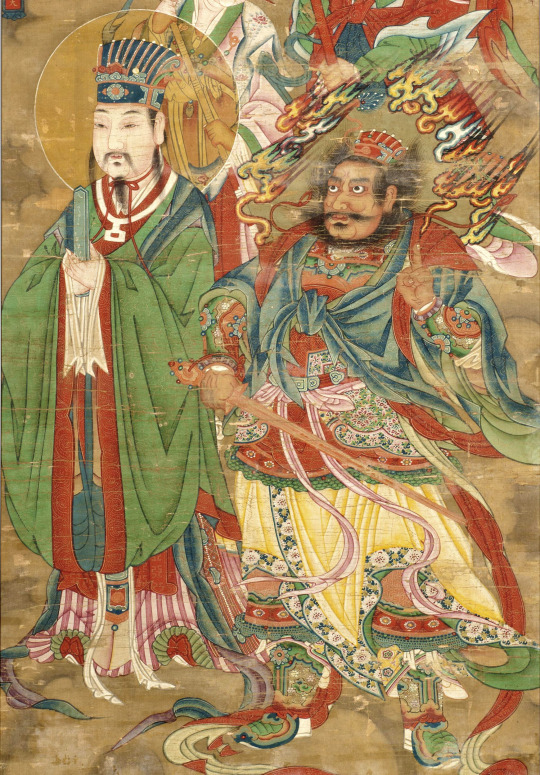
Qing dynasty Chinese Water and Land Ritual painting depicting a divine civil official and thunder god in military regalia. [Wen - wu]
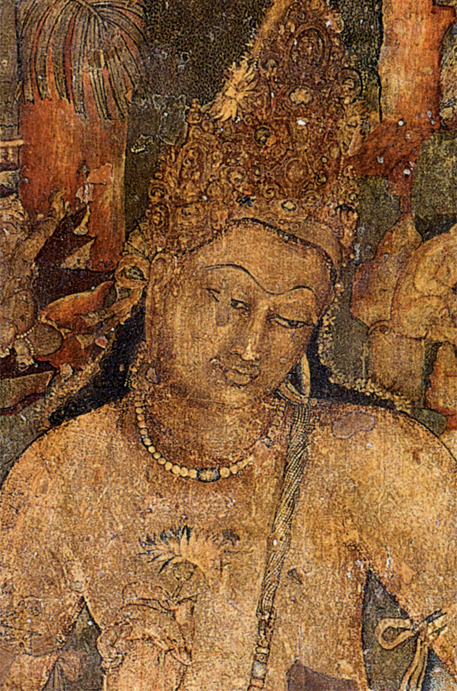

Paintings of Padmapani and Vajrapani on either side of the Buddha, from cave 1 of the Ajanta Caves.
Moreover, if the problem is hinging on a particular understanding of seme/uke: the one in which seme is not feminine or uke is not masculine enough. If latter is the issue, it can be fixed by sticking to BL media with otokomae uke or macho uke. If former is the issue, there’s more than enough works with maiden seme and josou seme. If one is yet to encounter any such works, one is not looking far enough.
Masculinities in BL

Here are three central characters from Finder series embodies different types of masculinities – a lot of it is presentation, physical attributes, age, power and social standing.
Akihito is a young and vivacious uke who happens to be short and sinewy.
Asami Ryuichi is a supadari seme: a guy who is tall, well educated, high earning, with good looks. In addition, he cooks and cleans and cares when he wants to.
Fei Long is tall, beautiful and cunning and can be regarded as a riba character.
But can any of these characters considered not masculine by regular standards? Isn’t Akihito masculine enough for his age? And if we are to compare Asami, we are sure to find him lacking but then give him time to grow. They have a dozen years between them. Moreover, can average men stand comparison with a super darling? But then in the grand setup of patriarchy, isn’t power concentrated in the hands of the older men who dominates even the super darlings, both in real world and fictional ones.
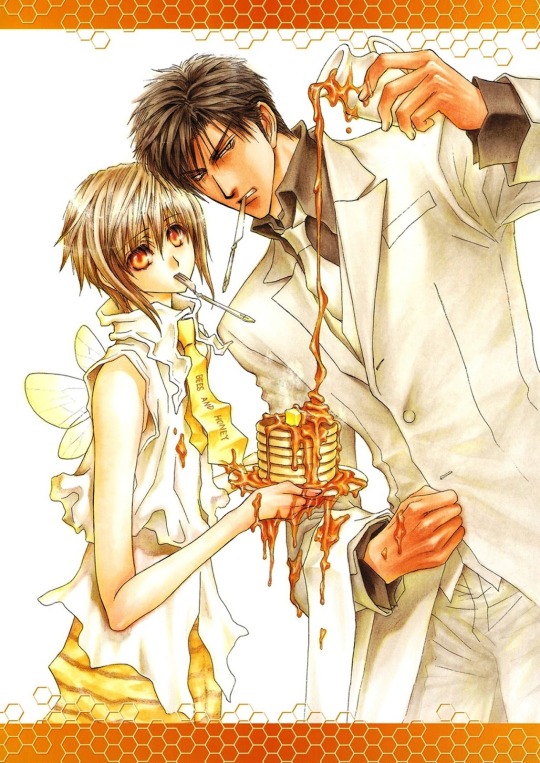
Ayase Yukiya & Kanou Somuku from No Money
Consider the case of Ayase, would you call him a “feminine” uke? Probably yes. He is small in stature - petite and cute. He is definitely very small in comparison to his seme Kanou. They probably have one of the most exaggerated size differences and an extreme case of the traditional pairing.
The traditional pairing comes from the customary practice of androphilia in pre-modern Japan. It involves relationship between a wakashu and a nenja or from the tradition of nanshoku. The former is not considered a man by the period’s standards and is considered a third gender by some scholars. The latter is considered as a mentor and lover for the former. While the traditional faded with ‘modernization’, tanbi literary movement (among others) kept alive remnants of it through the writings of the likes of Yukio Mishima.
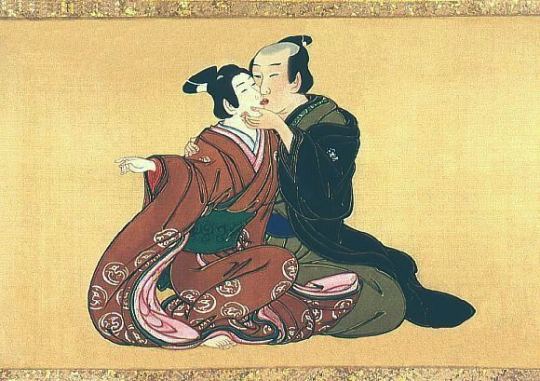
Note that the youth on the left is wearing a kimono whose style (furisode) and color was considered appropriate for adolescents of both sexes but not adult men, which along with the partially shaved pate denotes the boy's wakashū age status while the exposed bare feet indicates the purely sexual demeanor.
The traditional pairing has clearly inspired Japanese mangaka both BL artists and others. Look at the wakashu in customary androgynous clothing, younger, fairer and even smaller than the nenja, with relatively less experience being embraced by nenja who is in customary male clothing.
Check out more shunga about nanshoku to see visual ancestor of “yaoi”. The visual legacy continued with the likes of Go Mishima. The queers did it first.

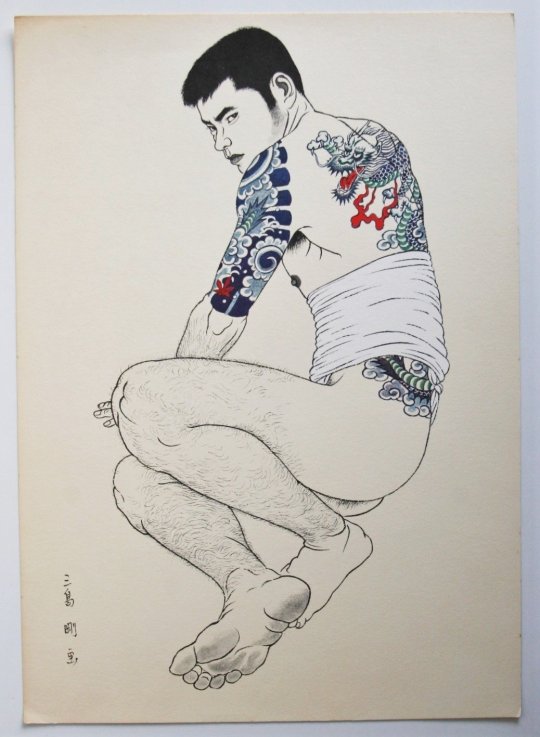
From the series "Mishima Go Book of Young Man" - Japan - 1972 (Showa 47)
Ayase in No Money fits into the wakashu ideal. Moreover, the creators of this manga explicitly differentiated between feminine uke with wakashu uke by juxtaposing Ayase with Someya who embodies traditional femininity.
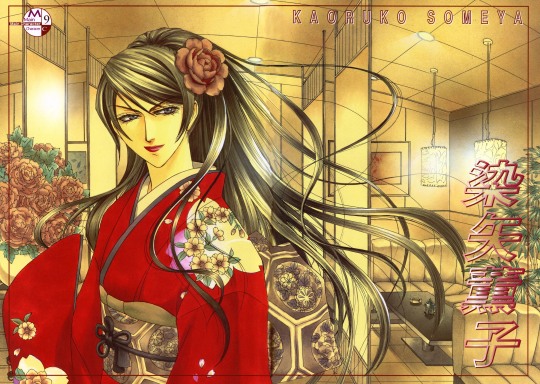

Someya and Honda from Henshin Dekinai
Putting it into perspective, it is noticeable that many a BL involves similar pairing. A lot of criticism BL faces is when it sticks to nanshoku dynamics. Interestingly, critics who can’t imagine genders beyond masculine and feminine, fail to tell apart “feminine” characteristics from wakashu characteristics. But there is no dearth of such dynamics getting subverted in numerous ways in BL:
ship with younger, lower class, petite, androgynous or any combination of customary wakashu characteristics in seme/riba.
ship with all parties being of similar age, class, physical attributes, experience, etc.
Emancipation
Shouldn’t typical uke archetype be seen as an example of subversion of the main character masculinity that dominates media landscape? Shouldn’t they be exalted for being what they are? Uke archetype that allows all genders to project onto and gain pleasure from, is that any less than a marvel in itself?
Pursuer & Pursued
In order to analyses if there is a shift in seme-uke dynamic, the P’AbsoluteBL employs the following to categories who is active:
who is pursuing whom
who makes the first call in terms of declarations and physical touch
who seems to be more in charge of the relationship
In BL, these are never reserved for seme/uke/riba. Who takes on which role depends on the narrative. BL rarely have fixed pursuer-pursued. All parties involved in a ship take on active role in different circumstances.
Take, for example, the original edition of Ossan’s Love, Hasegawa Yukiya employs certain indirect tactics to pursuing Soichi Haruta such as cooking, cleaning and caring for him. (These are tasks that seme/riba/uke usually engage in lighter BLs to gain and retain the attention/affection of the one they are pursuing.) Hasegawa also engages in activities they do together as a means to grow closer.
Once he learns of his love rival, he switches up the tactic. He pursues more directly and aggressively. Soichi rejects him. He withdraws and returns to the original tactic but without attempts to grow closer.
Soichi feels the loss and tries to get close to Hasegawa but is brushed off. He does not back down. Instead, he takes on a more aggressive route of pursuit - making amends and chasing after Hasegawa.
What P’AbsoluteBL implies with “I think BLIHID’s main couple has a REALLY weak seme/uke dynamic from the get go” is made abundantly clear in with “ShiLei does a lot of active pursuit, also he’s very self actualized.” Here, using pursuer/pursued would have sufficed. Instead, P’AbsoluteBL chose to disappropriate established terms ‘seme/uke’ and imbibed them with implications of “active pursuit” as well as “self-actualization” [regarding queer identity] that seme/uke/riba doesn’t carry originally. Most of it based on biases built on equating all BL to one type of BL: the one with traditional pairing that follows royal road progression.
What P’AbsoluteBL actively avoids discussing is that Beloved in House is basically following the super popular ‘domineering president’ plot based on a BG romance.
Live Action Struggles
P’AbsoluteBL mentions an imagined ‘struggles around seme/uke’ in live-action BL. I think the actual issue plaguing live action BL is the struggle to balance business and other interests while being able to do justice to the diversity within BL as a media genre.

source: (chil-chil.net)
In the chart:
ほのぼの – heartwarming – Example: Restart After Come Back Home
コメディ – comedy – Cherry Magic
ダーク – dark – Sing in Love
シリアス – serious – Cornered Mouse Dream of Cheese
キュン – exciting (kyun) – Mr. Unlucky Has No Choice but to Kiss
Japan has trouble in diversifying its live-action in terms of sub-genres and treatment/mood. Even Thailand, despite the amount it produces have trouble offering variety. Riba couple, maiden seme, yarachin characters, yandere X yandere ship, etc. are either very rare or non-existent in live action BL. Moreover, live action BL is seldom explicit and are mostly in the speculative territory with seme/uke/riba dynamics, making it all the harder to diversify.
Tbh, what fascinated me the most is the “I kind of automatically cringed” part of the question. I would love to know what brought about that reaction. I am sure that it would help shed some light on discourse surrounding BL in general.
Post #2: Blushing Maiden Trope & Seme/Uke
Discussion (intended and in italics) between an anon, @heretherebedork & P’AbsoluteBL on actions and reactions during physical relationships.
The discussion centers around “the character placed into the stereotypically feminine role” being repulsed/reluctant/hesitant when it comes to physical relationships. It is directly attributed to “purity culture in BLs”.
BL have a complicated relationship with “purity” or being “clean”. Tanbi roots of BL hinged on sexuality and obsession with beauty to the point of decadence. Shonen ai (original meaning) works also had characters who are usually promiscuous for one reason or the other, never forming very deep relationship (at least not enough to stick to monogamous unions for long) yet endlessly entangled with other characters, often baffling non-queer characters in those works.
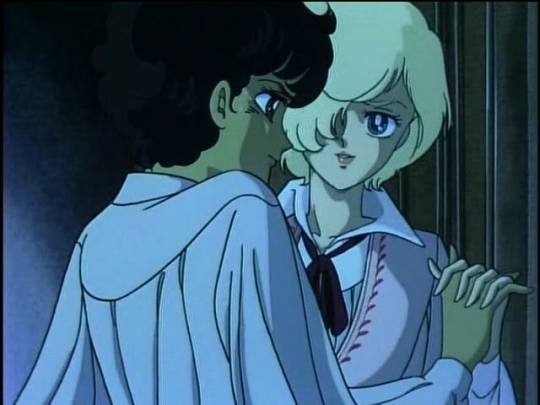
from Song of the Wind and Trees
*
[Inviting readers to hazard a guess: who is the seme and who is the uke. Answer at the end of this post.]
*
But how explicit the depiction of physical relationships has varied in BL with time and space. Japanese BL with the self-published BL (aniparo / yaoi – original meaning) boom saw very explicit depictions side by side with the commercial BL which have barely any explicit content or those which take a closed-door approach. Now Japanese BL have a wide range in terms of explicit content and have grown to incorporate elements from other genres including gei comi. Korean BL is similarly doing well. It is not uncommon to have chapters or parts of chapter in manhwa and novels dedicated to the celebration of physical relationships. Thai BL also have no dearth of explicit content, especially in web publishing.
Chinese BL in its early days had lots of explicit content, especially in self-publishing. But as censors started taking notice and cracking down, authors and platforms clamped down. Most BL were purged of any & all explicit content. Some of it migrated to Taiwanese platforms, AO3 & other foreign hosts. Now all danmei published is “pure love” devoid of even allusion to depiction of any physical relationship beyond above neck action.
When it comes to BL live action, things are a little different. In Japan and to an extend abroad, there has always been overlap between audience of BL and audience of Japanese GVs and pink eiga. Moreover, early live-action Japanese BL was probably aimed exclusively at hardcore BL fans. They were way more explicit on average and did not always involve physical relationship between the main ship.
Same seems true about early live-action Chinese BL. A Round Trip to Love Part 2 (2016) even had bondage and SM scenes which wasn’t there in the novel; but then it didn’t have the hard-earned happy ending the novel had either. But now, even dangai with “socialist brotherhood” (社会主义兄弟情) can’t be aired. Meanwhile, Japan’s average BL today lacks much explicit content. This isn’t to say that it doesn’t drop an occasional Sei no Gekiyaku (2020) once in a blue moon. Here are my speculations to why more of those doesn’t get made.
There is another reason for “purity culture” in BL.
Sathaporn Panichraksapong, an MD of GMMTV, a major producer of BL series, claimed that audience members who are mainly heterosexual women look for romantic relationships among the characters rather than sexual relationships.
We know that our audience are [sic] women. Women want to see only two boys having romantic moments together. They don't want to see sex. Sexual relationships in BL are for a gay audience. That's why in SOTUS the Series we have only two kissing scenes. With only these, audiences were already screaming. This is enough for them. (Interview with Sathaporn, GMMTV, 10 Aug. 2017)
Jirattikorn, Amporn. "Heterosexual Reading vs. Queering Thai Boys' Love Dramas among Chinese and Filipino Audiences." (2023).
As Jirattikorn goes on to highlight, this [wrong] perception about the audience (“women”) have changed ever since.
While early BL series tend to portray pure love without showing many sexual relationships, later BL series started to show more sex scenes between the two male lead characters.
Jirattikorn (2023)
“It’s always the character being pursued, who is typically in his first relationship, who Never Thinks Of Sex. They’re often very sweet and innocent and wide-eyed.”
While heretherebedork attributes it to “purity culture”, it can be argued that this has to do with what audience wanted:
I like the way they portray love in Thai BL. It is a kind of puppy love. BL of other nations, like Chinese BL, are darker. In Thai BL, two male characters often start off friends, then develop feelings for each other. It is very light, very sweet. (Krissy, f, 27, Philippines)
Jirattikorn (2023)
and what media houses thought they wanted, as evidenced by Jirattikorn’s interviews with BL fans. This is not to dismiss struggles with purity culture which is often a very slow part of decolonialization.
P’AbsoluteBL goes further to the argument that “purity” is associated with seme/uke dynamics in BL and maps it to typical het pairing (BG):
The stronger the seme/uke dynamic (the more heterosexually dysmorphic and less actually gay) the more likely this trope will manifest. Simply put: the man (because he is hooah a MANLY MAN DUDE) wants sex but the woman (delicate pure flower of cleanliness and joy) does not. And if she does want it she is a DIRTY, worthless, whore - so she MUST protest sex (GASP) at every single turn. (Seme is acting the male and uke the female in these kinds of narratives.) *please sense my sarcasm dumb interwebs, mm’kay?*
It’s true that the argument seems persuasive but is it right? Probably not. Seme, uke and riba characters can be divided into strong/weak categories based on their characterization - with the strong ones being those who pursue, take initiative, most likely to initiate intimacy at least for their first time, etc. and weak ones being those at the receiving end of pursuits and initiatives. Pairing a strong one with a weak one is probably more traditional –
strong riba x weak riba like in Addicted (at least before time skip)
strong seme x weak uke like in Old Fashioned Cupcake
weak seme x strong uke like in Saezurutori Wa Habatakanai (at least before time skip; pavam Doumeki)
compared to those with both parties being strong (which leads to delectable friction and sparks flying when done right) or both being weak (which leads to audience wondering: will either of them do something? No? Very well!).
BL’s sex negativity
Seme gets overwhelmed by his lust for uke, acts aggressively and has to be shut down or warned off.
Not only seme, uke and riba characters does this too. P’AbsoluteBL attributes “getting overwhelmed by lust” and “acting aggressively” to seme when it can be attributed to both uke (襲い受け) and riba as well. Other than acting aggressively, characters may employ seduction (eg. Xia Shang Zhou in You Are Mine (2023) - tried and failed & Charlie in Pit Babe (2023) - successful) and/or manipulation (Color Recipe by Harada).
Seme won’t take no for an answer because his needs are too great and his needs take precedence (he’s “the man” after all) and the uke is just TOO CUTE how could anyone resist? (After all the seme is only gay for this one guy because he is so cute. Everything, therefor, is the uke and his cutenesses’ fault.)
Moreover, P’AbsoluteBL is probably not aware of kawai seme who employ their cuteness to get uke to lower the guard and to seduce. Cuteness is clearly not a uke prerogative.

Like the sailor-costume wearing seme on the cover, cuteness is sometimes invoked through conventionally women’s clothing, cosplaying (maid, sailor, nurse), etc.
If the seme makes the choice to have sex for the uke, then the uke is not at fault and is still technically innocent. Only if an uke wants it, is he actually impure (or actually gay). In H4 when they both comfort and sex shame the bottom after the rape sequence, this is the narrative’s mentality. (A man who does not want sex is assumed to be able to fight another man off.)
Oh and ALSO, the seme must read the uke’s mind and know what the uke really wants.
I don’t even know what went into this argument. There is an entire subgenre: 調教 BL (training / conditioning) that is focused on pleasure training. If a character (seme/uke/riba) wants sex in a narrative, it usually only means that their partner is on the right track. Moreover, when a character wants, actively seeks and are denied intimacy for manipulation reasons, then their partner is made out to be cruel (either 鬼畜 or ゲス・クズ).
In other words, if the uke is interested in sex, he’s made impure by this interest.
Sex of any kind is an act of desperation and indicates lack of control and therefor diminishes both parties but particularly the uke, therefor the uke shouldn’t have to take responsibility of wanting sex, so the decision must be made by the seme for both of them. He is being a “good seme” by doing this. The uke, therefore MUST appear reluctant to have sex, or he is not a good/pure/virtuous person.
Honestly, I haven’t come across BL which gives off this kind of message. However, two-faced scummy characters (seme/uke/riba) get to employ hypocrisy, which includes slut-shaming, to humiliate characters they are shipped with but then such narratives are built to illicit hatred (for scummy characters) and angst and often punished with:
(a) unhappy ending for the couple
(b) breaking up of the ship
(c) groveling which may or may not end in redemption of the scum
(d) switching within ship – uke turns into riba/seme or seme turns into riba/uke – or shift in power dynamics (rich character becomes relatively poorer, junior from school becomes senior/superior in workplace).
A lot of readers find such dramatic plots satisfying and hence it is a successful subgenre.
*
Can you guess the seme in these 20 BL manga? Try this quiz on renta.
*
Post #3: How do they determine who will be archetype seme/uke?
Discussion regarding seme/uke determination in BL: @elynn0723 & P'AbsoluteBL (intended and in italics).
I think your confusion is partly nested in the fact that seme/uke is not about who fucks who, not really. Certainly not anymore. Seme/uke are narrative archetypes not physical acts.
Disappropritation. Discussed above.
I should say for the record that personality is NOT sexual preference.
P’AbsoluteBL goes onto give examples (all of which are fictionalized in different genres – GB, BL, etc.) but probably due to being limited by lack of exposure, goes onto ask, “How weird that anyone would think queers do this.” Queers do this. If one is willing to look beyond LGBTQIA+ form of queerness (which is born and brought up in America), one can see queer possibilities. For example, Kothi-Panthi queerness in India/South Asia. It is probably a good idea to pay attention to it when generalizing queerness given how big India/South Asia’s (queer) population is. There are very many similar forms of queerness in other parts of Global South. In many cultures, sexuality doesn’t inform identity but sexual preference does.
[ Aside: Kothi-Panthi model of queerness
This model doesn’t work for whole of India – region (India is so big and heavily populated - different sexual cultures and practices); linguistics (different terms in different region, same terms different meanings in different region, decline of Farsi (used in queer spaces in Delhi) and other queer argot/cant and their replacement with American English internet slang); class & caste (LGBTQIA+ being self-identification of mostly urban/rurban, upper class, English educated v/self- identification common among the sex workers, working class and other lower classes in rural as well as urban spaces who are excluded from consumerist queerness);
NGOfication of queer movement & action; global queering and neoliberal take over leading to americanization –– intermixing & “gay” (and other terms) being used differently by different classes.]
How do they determine who will be archetype seme/uke?
P’AbsoluteBL points to narrative roles - who is “after” the relationship more, and then goes onto claim “the heroine is the main character, the love interest is her love interest. It’s decided for them because it’s a romance novel.” I don’t know if this helps explaining either seme/uke/riba archetypes in BL or pursued/pursuer. Aren’t there romances where hero pursues heroine and the other way around? Aren’t there romances where both party pursue each other?
Even if we assume that androphilic female audience is projecting the sexual mores & expectations imposed on them onto male characters, then by the very act aren’t they subverting those expectations.
How do they determine who tops?
P’AbsoluteBL provides the following schema:
seme = active pursuer
since active pursuer is “the male role”
he should do the penetrating
which has to be done
P’AbsoluteBL also gives a term for this association: heterosexual dysmorphia - "the idea that any couple must fit into predetermined binary gender roles". This is probably coming from a place of ignorance since the example given is confined to musings about sexism concerning the upper class in Global North.
Also, at least in the ambit of Kothi-Panthi sexuality, fitting into masculine top-feminine bottom dynamic doesn’t place them into any predetermined binary gender roles. Instead, it only places them in the fluid space of multi-genders: can/are seamlessly float(ing) between being kinnar/hijra/ali and being “cis-men”.
If one is to ask the question: “Which one of you is The Girl?” to a kothi-panthi couple, the kothi would tell you without hesitation: “I am The Girl.” Might even asked you in turn, “Couldn’t you tell?”
Kothi [is the word used by] effeminate men who desire to be penetrated by "real" men whom they call ‘panthi’.
Queer Movements by Paromita Chakravarti & Aniruddha Dutta
Seme/uke/riba archetypes are imbibed with different traits and different spin on personalities that a seasoned BL sommelier might be able to spot easily but would confuse those who are less familiar with all that the genre has to offer.
The following excerpt from an analysis by @ranchthoughts reflects the most popular idea about seme/uke dynamics.
Most BL shows can be read through a lens of seme/uke dynamics, which originated in yaoi. The seme is the “pursuer” character and the uke is the “pursued”. There are certain physical (height, skin colour, etc.), social (age, wealth, social capital, etc.), and personality (active vs. passive, extroverted vs. introverted, flirtier vs. shyer) markers which are typically associated with either the seme or the uke. For example, semes tend to be taller, wealthier, older, flirtier, tanner, more active, and have a higher social status, while ukes tend to be shorter, poorer, younger, shyer, paler, and have a lower social status. “Seme” and “uke” roles are also sometimes conflated with masculinity and femininity (semes are “masculine” and ukes are “feminine”) and sexual preferences (semes are dominant and tops and ukes are submissive and bottoms). There are also tropes associated with either the seme or the uke, like ukes typically give cheek kisses and semes forehead kisses.
Thus, things like height, age, wealth, personality, presumed sexual preference, and the role they take in tropes can index the character’s status as a seme or a uke, and in turn the character’s identity as a seme or uke in the narrative (pursuer vs. pursued) indexes a character’s personality, sexual preferences, etc., however unrealistic and simplistic that is in real life. In a BL, we would expect the seme (pursuer) and uke (pursued) characters to exhibit most, if not all, of the associated seme or uke traits and roles in tropes, though this is not always true (and some BLs have little to no seme/uke dynamics at all).
There are two interesting things about such an understanding of seme/uke dynamics:
It closely resembles nenja/wakashu dynamics (and its cousins) in the customary and mostly age-stratified androphilia in pre-modern Japan.
Live action BL, at least the ones that were current and popular, stuck mainly to a single type of dynamic: pairing of one seme of a particular kind (スパダリ – super darling) with one uke of a particular kind (ヘタレ – milquetoast). There are barely any riba couple. It is painting picture of BL in monochromes. So much so that Bad Buddy and My School President were seen as some path breaking feat and a break away from “yaoi” tropes by live action audience, rather than seeing them having just another (or less familiar) set of yaoi / BL tropes.
What P’AbsoluteBL identifies as “heterosexual dysmorphia” in “yaoi” is basically what BL inherited from Japan’s pre-modern androphilia including “femininity” in uke from chiago, wakashu and androgynous Kabuki actors and (hyper)masculinity in seme from nenja and others who enacted “the male role”. BL did not passively receive any of these. And for moe, artists and audience alike, subverted it all.
This is true for all tropes that are attributed to seme/uke.
Height difference – Earliest BLs had petite bishonen pairings. Yaoi introduced height differences – all of them:
tall seme x short uke
short seme x tall uke (this is probably the most sexualized height difference)
tall seme x tall uke (with little to no difference)
both/all short riba CP/ship
both/all tall riba CP/ship
tall riba x short riba
short riba x tall riba
Cuteness – Used to establish how irresistible a character (seme/uke/riba) is irrespective of their attitudes and behavior are. Oft part of seme’s seduction tactic, especially when uke has a weakness for cute things. Even when cuteness is not one of the seme’s attributes, it is invoked either actively by serving kawai in speech or through actions including cosplay; or passively like in the following example where a typical super darling seme, Asami Ryuichi from Finder unintentionally triggers moe in Takaba Akihito (his uke) by cuddling a baby.
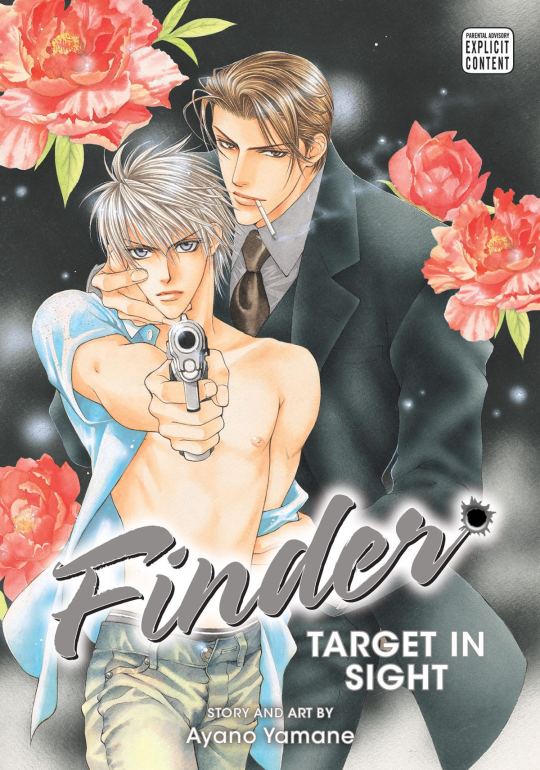

Uke’s cuteness is exploited to establish a sou uke (an uke every other character turns seme for) or subvert the same like in No Money where one of the epitomes of bishonen cuteness, Ayase (uke), who manages to enthrall others however isn’t a sou uke as one might expect and thus subverts the wakashu trope.
Moreover, Kanou (seme) wasn’t initially drawn to Ayase due to his cuteness but due to Ayase’s kindness that lifted him out of the abyss of despair, when Kanou was at his weakest.
3. Bulk – BL have main characters (seme/uke/riba) with varying bulk and body types. There is far less diversity when it comes to Live Action BL.
4. Blushing maiden/virginal innocent trope – applies to all sorts of BL characters.
Edit: Conclusion
1. Surprisingly, ethnocentrism and loud echo of colonial masculinity in particular seem to permeate the discourse surrounding BL.
2. I really wish live action BL would have as much diversity as other BL media. Why is it so slow to diversify? Is it because of business interests? Is sticking to super darling X milquetoast pairing with royal road progression a sensible business decision? Or is sexism promoting wrong impressions of what audience want?
3. How come the Japanese terms "seme" & "uke" are used a lot but not "riba"? Where did live action BL audience learn these terms?
***
Yaoi = [how P'AbsoluteBL uses it] synonym for ボーイズ ラブ (boys love) manga.
= [popular use in anglophone BL manga fandom] BL manga with explicit content; as opposed to shonen ai.
= [original meaning] derivative works, which were mostly plot-what-plot type, that are self-published (doujinshi)
Answer to a question posted above: Gilbert Cocteau – uke in Song of the Wind and Trees

Below is the seme: Serge Battour

from Song of the Wind and Trees

Earliest BL manga had very pretty seme/uke/riba characters (if we are to call them so) and were not too preoccupied with "manliness" or a single type of "masculinity". But, they were surely obsessed with bishonen.
-
[1] 互攻 is also used to indicate POV switching between gong and shou in fiction.
[2] 纯爱 is also used to indicates asexual androphilia.
CP/pairing - involves 2 characters. Ship - involves 2 or more characters.
Inviting @waitmyturtles and @lurkingshan to share your thoughts if any (since I have noticed you guys use the terms "seme" & "uke" as well). Hope you guys don't mind the mention.
#japanese bl#boys love#bl history#thai bl#chinese bl#danmei#bl trivia#bl tropes#seme/uke#seme#uke#riba#korean bl#taiwanese bl
90 notes
·
View notes
Text
Author and scriptwriter Watari Wataru on cynical heroines, getting a lesbian kiss onscreen, and keeping his day job

Watari Wataru’s appearance at Otakon 2023 was announced with copious mention of his 2011 light novel series My Teen Romantic Comedy SNAFU (sometimes known by the shortened portmanteau of its Japanese title, Oregairu). While it has its issues (like a spate of fanservice-heavy anime promotional material rather disconnected from the novel’s mentality), it’s also drawn comparisons to era contemporary Toradora for trying to integrate more grounded character dynamics into the extremely archetype-dense school rom-com genre. The series earned a dedicated fanbase, three anime adaptations from 2013 to 2020, three separate manga adaptations and three visual novel spin-offs (including one in 2023).
Even more of interest for AniFem readers, though, is Girlish Number. Its heroine, Chitose, is a cynical young voice actress who finally manages to snag a major role; convinced she’d just never been given a chance to shine, Chitose’s ego takes a serious blow when she can’t keep up with her costars. The series isn’t a brutal indictment of an industry a la Perfect Blue or Oshi no Ko, but a work-com closer to SHIROBAKO – ultimately upbeat but unafraid of airing its complaints, or of letting a cast of adult women have a few rough edges.
Stepping into the role of anime scriptwriter and series composer first to adapt his own work, Watari has increasingly taken up work on adaptations. In 2023, that included AniFem staff favorite The Magical Revolution of the Reincarnated Princess and the Genius Young Lady, an ambitious fantasy series that turned heads for managing to include both a love confession and onscreen kiss between its titular couple.
Such a move is almost unprecedented outside of titles marketed exclusively as yuri or BL, and despite the many beautiful queer love stories that anime has told over the years with one, the other, or only subtext to wield, it’s easy to see why this achievement touched anxious viewers: this interview was conducted only one day before Bandai Namco attempted to declare the couple at the heart of Mobile Suit Gundam: The Witch From Mercury as being “up to interpretation” despite, among other things, their matching wedding rings (the creative team, in an admirable answering power move, released a staff art book at Comiket that included wedding and honeymoon art).
We were able to sit down with Watari, as well as SNAFU editor and Gagaga Bunko Chief Editor Hoshino Horinori, for a short interview.
Read it at Anime Feminist!
#girlish number#the magical revolution of the reincarnated princess and the genius young lady#magirevo#tenten kakumei#tensei oujo#oregairu#my teen romantic comedy snafu#chitose karasuma#articles
159 notes
·
View notes
Text
Round 2, Match 4: Jiang Cheng vs Yoshikazu Miyano

Match 4 is between Jiang Cheng (shixiong: Wei Wuxian) from Mo Dao Zu Shi vs Yoshikazu Miyano (shixiong: Shuumei Sasaki) from Sasaki to Miyano
Propaganda under the cut (Miyano's propaganda is going first due to how long the Jiang Cheng propaganda got)
Yoshikazu Miyano:
A fudanshi who bonds with his senpai over BL. Sasaski actually fell for and confessed to Miyano first but Miyano is took his confession very seriously and made sure to sort his own feelings out before giving a proper response (which took like a year lol) beause he didn't want to be careless with Sasaki's feelings.
Jiang Cheng:
Clinged to WWX constantly for 7+ years, wanted to have WWX as his right hand man forever after becoming sect leader, cried after WWX left, cried when he discovered what WWX sacrificed for him, was TORN APART when it got explained to him that if they were more outwardly close knit, WWX might not have died
PROPAGANDA!! to start, i'm still very bitter about how fairy lost the sentient animal poll and i want to win this badly. very very badly. current stats are 50.6 in favour of jc but that's too less of a gap for me. jc should be winning this by a landslide, y'all hear me? anyways. starting with a class act, like the clown i am->

a few links ( because i'm chengxian trash, as always and i'd love if poll-guy could copy paste them on the og post): one, two, three, four (gif), five, six, seven (gif), eight (thoughts on different wavelengths), the absolute circles of them saving each other, the fucking golden core reveal scene. golden scene reveal part 2, jiang cheng will always forgive wei wuxian
to start with. jiang cheng is literally the picture of "i knew from the moment i met you that i'd spend a lifetime forgiving you".
the earliest dynamic of jiang cheng and wei wuxian is jiang cheng giving away his dogs (the only gift his father has ever given him, btw) because wei wuxian is scared of the dogs. tis only the start of it.
his father very obviously prefers his shixiong over him, his mother berates him for not being as good as wei wuxian and tells him his inheritance is in danger, and his sister (in my opinion) has more care for him (visibly. maybe jiang yanli doesn't show it because jc is an emotionally complicated purple grape, maybe because jc doesn't need it, or wei wuxian is traumatised but that's my opinion). but still. still. Jiang Cheng loves Wei Wuxian. so much. jealousy is like. the most tame response i can think of. and jiang cheng is proud of wei wuxian, okay? he'd believe his big brother if he'd said anything. want proof? well, here you go-> link
to paraphrase the link:
Jiang Cheng had just lost his family, his home, and his very golden core, and his older brother - his brilliant older brother who could fix anything, who could sneak wine into Cloud Recesses and defeat an ancient turtle nearly-god and make Jiang Cheng share a smile when Jiang Cheng’s mother was disappointed and furious at both of them - His big brother smiled and said, “I can fix this.”And Jiang Cheng believed him then, and believed him three months later when Wei Wuxian crawled out of the Burial Mounds (just the second miracle in three months), and believed him every day of the next seventeen(?) years until the pieces were shoved into place for him to see.
also. the circle these two go in protecting each other. (gif set by @sandushengshou), the 'if one of us is to die, then, i beg, let it be me' that they both do for one another in a seemingly neverending loop of sacrifice. via this post a la my lovely @backtoyunmeng

jiang cheng is a cannonically ruined woman archetype, justified via the countless posts you'll get in the top posts of jiang cheng tag. he keeps chenqing, wwx's flute in perfect condition even when he hates wei wuxian, even when wwx, if only indirectly, has a part in jiang yanli's murder and oof okay someone pointed out to him that he's known to have killed wei wuxian and he almost cries. he absolutely believes, with his whole heart, that wei wuxian lives even when the world is sure he doesnt. and it always read to me like, i'd know if he was dead. he's a part of my soul, so i'd know if he was dead. he can't be dead.
this is getting too long, so, to sum up, some absolute poetry by @jiangchengsjawline

#JC On The Other Hand Has His Entire Life Shaped By His Shixiong And Ended Up Cast As The Ruined Woman By The End
#jiang cheng though. wasn't able to fuck his shixiong but his shixiong definitely fucked with him
#hello?? the answer is Jiang cheng pls#he's the shixiongfucker or all shixiong fucker you wish you could be as pathetically in love with your shixiong as he is#chengxian
#i do not go here (chengxian) but the propaganda is incredibly correct they are insane abt each other#also sorry jiang cheng ik you're suffering but they are so funny to me#neway VOTE JIANG CHENG FOR CLEAR SKIN
#look I rarely go here#(here being chengxian)#but by GOD their lvoe compels me#they’re tragic and doomed and they love each other without knowing how to say it in words the other would understand#or in words at all because communication??? we don’t know her???
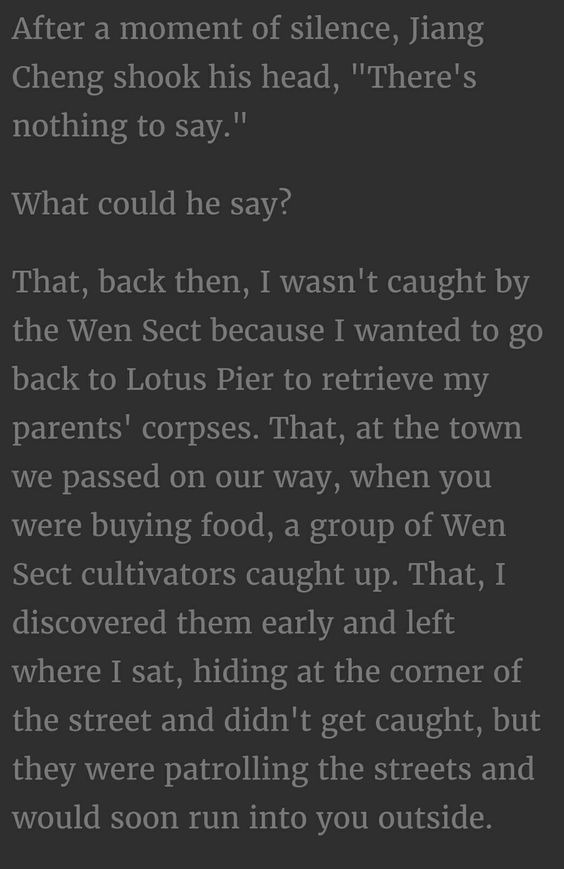
he didn't even think about sacrificing himself, and consequently his entire bloodline, his sect, pretty much everything that depends on him for his shixiong??????????
is this not convincing->

#had to vote jc though i have more feelings about chengxian#i think jc should have a huge gege kink
#like. jiang cheng should win the entire tournament hands down period
#yoshikazu miyano#sasaki shuumei#sasaki to miyano#jiang cheng#wei wuxian#chengxian#mo dao zu shi#mdzs#the untamed
39 notes
·
View notes
Text
Definitions and Classifications of Yuri (Third Revision) - yuri315
(This is a translation of a 2018 blog post by the user yuri315 on hatenablog, originally found here. I find this author's system incredibly thorough and interesting, as well as the examples they provide of most of the relationship types, so I wanted to translate it and share it with other yuri fans on Tumblr. I included notes on important information that I thought required additional context, and provided links to all of the manga and anime mentioned, in English when possible and in Japanese when no English was available.)
At present, in order to roughly group together a great variety of relationships as "yuri", the question of where the line is on what can be considered yuri, whether a certain work can be called yuri, and other such unproductive arguments happen frequently. The purpose of this article is to create a general classification of the contents of yuri as a genre, in hopes of shifting the conversation from "is this yuri?" to "what kind of yuri do I enjoy?"
Of course, it can't be denied that the ambiguity of the definition of yuri, combining works following a variety of tastes and trends into a single genre, has been an aspect of the boom that's revitalized the genre. Understandably, there are concerns that clumsily subdividing the classification of yuri will cause a lack of cohesion and lead to the boom stalling and collapsing, when as it is now it hasn't even received a genre code at Comiket.* However, for the general public and new fans who don't share these assumptions, it may be difficult for them to understand situations where it isn't clear whether something is yuri, and they may not be influenced or restricted by those saying "X isn't yuri." Therefore, it is the author's belief that it would be significant for the yuri genre to have some form of comprehensive definition or classification.
Let's start with a provisional definition of yuri. Yuri can be described as "relationships between two or more women, and the genre of works that depicts those relationships." By analyzing what feelings and behaviors these "relationships" are based on, the contents of the yuri genre can be classified. In the following article, we will divide yuri into three broad categories: "Romantic Relationships", "Special Relationships" and "Friendly Relationships", and then establish a more detailed typology of how these relationships form and how they may be portrayed in each category. These designations are for convenience only, and the author is currently experimenting to find a better system.
(*TL note: Genre codes at Comiket—Comic Market, a doujinshi convention and the largest fan convention in the world—are used for attending artists/circles to categorize their work. Circles exhibiting works in the same genre code are grouped together in the convention space; there are currently no genre codes for yuri like there are for BL, even now, five years after this article was written.)
1. Romantic Relationships
Romantic and/or sexual relationships between women. This category includes relationships where there is a clear declaration of romantic love, or the relationship can be clearly understood to be romantic despite a lack of an explicit declaration.
1-1. Escape and Compensation
The story depicts indulging in a homosexual relationship as a compensatory act in order for a woman to escape, temporarily or permanently, from a situation in which her right to self-determination is threatened by coercive heterosexuality, such as arranged or forced marriages or betrothals.
1-2. Temptation and Conflict
The story depicts a woman being seduced into a homosexual relationship by another attractive woman, despite the conflict of their "forbidden love." The seducer is typically portrayed as leading the protagonist into an unknown world, often with tragic consequences. This is nearly synonymous with the "Crimson Rose and Candy" archetype defined by Yukari Fujimoto.*
*(TL Note: "Crimson Rose and Candy" is an extremely prevalent archetype in early yuri, originally depicted in Shiroi Heya no Futari, what is generally considered the first yuri manga. Despite its origins and association with yuri, due to the overlap in the genres and authors in the Year 24 Group, it's an archetype that was present in contemporary M/F shoujo and BL, notably Gilbert and Serge in Kaze to Ki no Uta.)
1-3. Self-Awareness and Confession
The story depicts adolescent girls becoming self-aware of their feelings and fluctuations in their sexuality, and, through confessing, beginning romantic relationships. Coming-of-age stories in school settings where the girls face problems particular to puberty are especially common.
Examples:
- Akira Okudaira x Fumi Manjome (Sweet Blue Flowers by Takako Shimura)
- Mariko Kumakura x Akiko Oohashi (GIRL FRIENDS by Milk Morinaga)
- Tsubaki Kureha x Ginko Yurishiro (Yurikuma Arashi)
1-4. Negotiation and Dialog
The story depicts a romantic relationship between women who are equal individuals. They are typically emotionally mature to some degree, and already aware of their own sexuality. Negotiations between them occur as necessary as the relationship progresses, and if problems or obstacles arise, they're resolved through dialog between the characters.
Examples:
- Momoko Naitou x Shinobu Handa x others (Shoujo Sect by Kenn Kurogane)
- Yukino Miyashita x Setsuko Iwai (Octave by Haru Akiyama)
- Tsukasa Shiratori x Mikage Kotooka x Nadeshiko Washio (Nameless Asterism by Kina Kobayashi)
1-5. Continuation and Stability
The story depicts women who are already dating or living together as a couple. The focus is on the continuation of an established relationship and its stability into the future, and concerns such as living arrangements or coming out to those around them. Most yuri of this type features working adults, and typically include sex or similar acts.
Examples:
- Maya Nagumo x Michiru Amamiya (Ohana Holoholo by Shino Torino)
- Arisa Suzuki x Mari Satou (Akarui Kioku Soushitsu by Oku Tamamushi)
1-6. One-sided Love
The story depicts one woman having unrequited feelings for another woman. This includes stories where these feelings remain hidden for the entirety of the work, or where she confesses and is rejected.
Examples:
Tomoyo Daidouji → Sakura Kinomoto (Cardcaptor Sakura)
2. Special Relationships
Relationships where the feelings between the characters are ambiguous but special, and can't be constrained by the definitions of either friendship or love. Regardless of the nature of the relationship, the common point is a sense of awareness that "this person is special to me." In most cases, the relationship isn't explicitly stated to be one of romantic love, but can still be said to be nearly a romantic relationship, or a pseudo-romantic relationship.
2-1. Magnetic Attraction
The story depicts an intense relationship in which the characters mutually resonate with one another on an existential or spiritual level, and are irresistibly and strongly attracted to one another, as if by magnetism or gravity. The invention of the term "magnetic attraction" is the greatest achievement of Sound! Euphonium and can be considered a major event in the world of yuri.
Examples:
- Kumiko Oumae x Reina Kousaka (Sound! Euphonium)
- Ange x Princess (Princess Principal)
2-2. Partners
The story depicts characters who become involved with one another in a half-formed way through fate or various other inevitable circumstances, and later develop a strong physical or emotional bond. It's a similar concept to "Forced Yuri", the tagline of MekiMeki's Only☆You ~Anata to Watashi no Futari Bocchi Keikaku~.
Examples:
- Haruka Tenou x Michiru Kaiou (Sailor Moon S)
- Papika x Cocona (Flip Flappers)
- Sara Ayafuji x Iris Kazari (Vampire-chan x Kouhai-chan by Sakaki Yoshioka)
2-3. Shelter
The story depicts a relationship that serves as a refuge from existential anxiety, miscommunication and societal oppression. There are similarities to 1-1 "Escape and Compensation", but instead of simple escapism, this type has the positive connotation of bonds between women facilitating healing, self-examination, and rebuilding one's way of life and relationships with other people in order to grow as a human being.
Examples:
- Utena Tenjou x Anthy Himemiya (Revolutionary Girl Utena)
- Rakka x Reki (Haibane Renmei)
- You Aizawa x Hana Kojima (I Want To Make You Cry by Bunbi Bun)
2-4. Buddies
The story depicts a relationship in which the characters act together to achieve a specific goal, and are connected by a strong bond of trust. Unlike 2-2 "Partners", these are often somewhat passive relationships where the characters' partnership is necessary to achieve their objectives, but over time they may realize their importance to each other and prioritize being together. Aside from truly equal "buddies", this can also include asymmetrical relationships like master-and-servant yuri.
Examples:
- Mireille Bouquet x Kirika Yuumura (NOIR)
- Sora Naegino x Layla Hamilton (Kaleido Star)
- Arika Yumemiya x Mashiro Blan de Windbloom (My-Otome)
2-5. Huge Unclear Emotions
The story depicts at least one of the women feeling incredibly intense emotions toward another woman. Specifically, there are three main types: evaluative emotions, such as good will, respect, admiration, envy or worship, obsessive emotions, such as possessiveness, protectiveness, dependence, or sadistic or masochistic desire, and hostile emotions, such as rivalry, jealousy, hatred, or a desire to kill. However, various emotions are often intricately interwoven in a way that is difficult to describe in one or two words.
Examples:
- Mamina x Roatreamon (Simoun)
- Madoka Kaname x Homura Akemi (Puella Magi Madoka Magica)
- Chariot du Nord x Croix Meridies (Little Witch Academia)
2-6. Closeness
The story depicts a slow awareness of one another in an intimate relationship. It involves the characters feeling safe when they're together, or having the feeling that they belong by one another's side.
Examples:
- Shino Kishibe x Nozomi Kishibe (I Live With My Brother's Wife. by Kuzushiro)
3. Friendly Relationships
Relationships that aren't particularly special, but are nonetheless amiable and intimate. This can include a huge range of relationships, from deep camaraderie and familial relationships to simple playful friendship between girls.
Of the above, 1. "Romantic Relationships" can be considered "true yuri", while 2. "Special Relationships" and 3. "Friendly Relationships" could be called "soft yuri."
#yuri#fandom#girls love#wlw#mine#translation#fan translation#fandom academia#maybe???#i hyperfocused on this so fucking hard#i found it last night. got up today. blacked out for 10 hours and now this is here. enjoy the yuri
336 notes
·
View notes